WoolWorks decarbonises Canterbury wool-scouring site
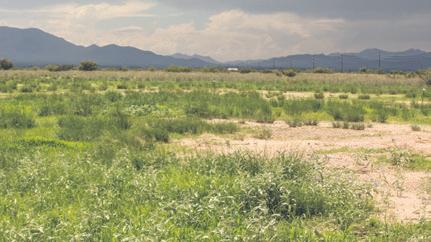
WoolWorks, New Zealand’s largest wool scouring company, has successfully decarbonised its Timaru facility following a $9.5 million investment.


] by Kent Caddick

The company has replaced a coal-fired boiler with a European eight megawatt electric boiler, reducing 11,000 tonnes of CO2 emissions per annum, or the equivalent of removing 3,000 cars off the roads.







The South Island plant is believed to be only the second early stage textile processor to become decarbonised in the world.
WoolWorks invested $5.85m in the project with EECA (the Energy Efficiency and Conservation Authority) contributing $3.65m through the Government Investment in Decarbonising Industry (GIDI) fund.
Business Development Manager at WoolWorks, Rosstan Mazey, said this was a significant milestone for the company and for Wool Inc. New Zealand.

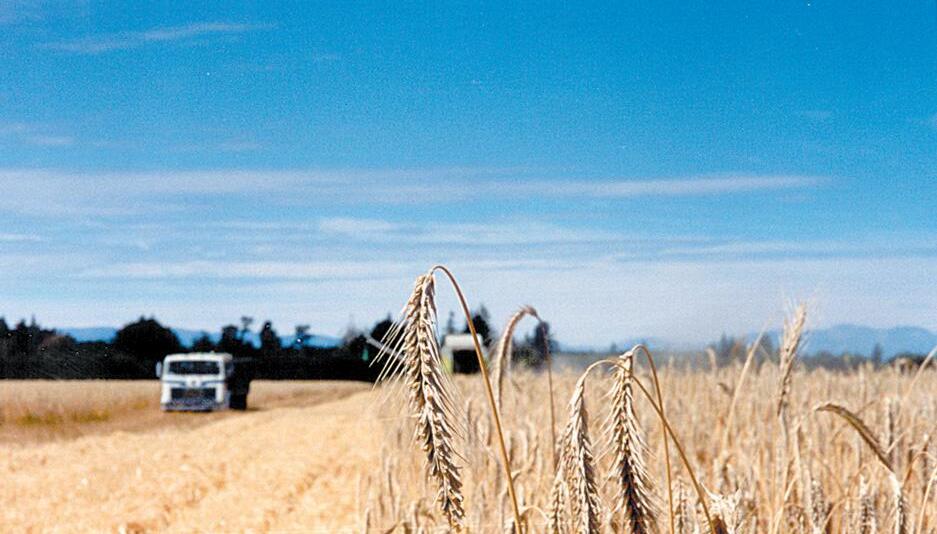
“While the apparel brands have been lead-






ing the way with championing the sustainability aspects of wool, the earlier stages of the supply chain have been slow to adopt carbon initiatives,” Mazey said.
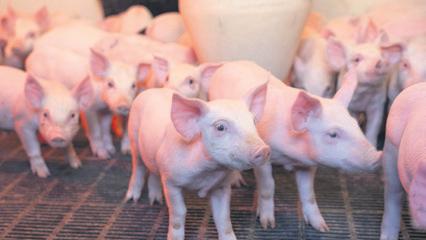
“The ongoing benefits for the wool industry are significant. We have just returned from a sales trip through Europe and the customers that we visited were very clear they wanted product from companies that are committed to climate action.”

July 2023 Edition INSIDE THIS EDITION Need a lawyer? OUR LOCATIONS: SELWYN 03 348 8480 WEST COAST 03 755 8673 CBD AND RICCARTON 03 348 8480 PARRYFIELD.COM Judith Bullin, Partner, Parry Field Lawyers ▪ Agri-business ▪ Disputes ▪ Wills & Asset Planning Our team can work to support your business growth or give you peace of mind around planning, property or personal matters. Talk to us today about how we can help. Getting the right advice early makes a difference. LOCAL LEGAL SPECIALISTS
PAGE 2
TO
30,287 copies distributed monthly – to every rural mailbox in Canterbury and the West Coast for over 25 years
Electrifying: Shane Thurlow of WoolWorks with Alpine Energy’s service delivery manager Damien Whiffen and the wool scouring company’s new electric boiler which will reduce the Timaru plant’s CO2 emissions by 11,000 tonnes per annum, the equivalent of removing 3000 cars off the roads.
New trade envoy p3 Glyphosate politics p17 Weirs & wells p27
p32
Welfare standards
Zero-carbon wool processing ‘preferred’


FROM PAGE 1
Mazey said not only was this the right thing to do, but this investment has also presented us with new commercial opportunities.
“For example, companies like VF Corporation, the owner of Icebreaker, have made public pledges to the Science Based Targets initiative (SBTi) of a 55% carbon reduction in their supply chain by 2030.
“Effectively, this means their partners must also demonstrate significant carbon reductions if they want to supply into that chain.
“Eco-credentials are of growing value for the New Zealand strong wool industry as materials and manufacturing processes are now being critiqued by conscious consumers and responsible manufacturers.
He said WoolWorks has positioned its business to meet the market needs now, and this is a significant advantage for New Zealand suppliers of woollen product who embrace a sustainable value chain.








“We see this achievement as an investment in the future that will lead to positive benefits for the New Zealand farmer as our wool exporters will be able to market the wool differently.
“International wool customers who are adapting their business to align with modern consumer eco-sourced products will view wool through this zero-carbon processing site as being positive and preferred versus nondecarbonised wool or synthetic alternatives.”
Mazey said WoolWorks believes that the best way to counter climate change is through reducing its carbon footprint, rather than forestry offsetting.
WE ARE BUYING!
Top job: Marking the successful decarbonisation of Woolworks scouring facility in Timaru were (from left) Maja Sliwinski (Investment Director Tanarra Capital Partners), Neil Vinson (Tanarra Capital Partners), Nigel Hales (WoolWorks Chief Executive Officer) and Rosstan Mazey (WoolWorks Business Development Manager).
WoolWorks chief executive Nigel Hales said to get a project of this scale and size over the line and essentially on time, during a pandemic, has been a Herculean task.
“We would like to thank all of those responsible for bringing this project to fruition and look forward to being of service to the New Zealand farmer and wool industry,” Hales said.

“WoolWorks would like to acknowledge
the support from its shareholders for having the commitment to get this project over the line, EECA, along with the GIDI fund for supporting the initiative with co-funding, Meridian Energy and Alpine Energy, for their roles, Lumen and the PEI group for their professional management of the project, and the Windsor Engineering group for the supply of the equipment.”








EECA General Manager Business Nicki Sutherland said businesses who take action and lead the way are a powerful example to others.
“Projects like WoolWorks’ Timaru site not only lessen the business’ impact on the climate but can reduce costs and improve competitiveness in a low-carbon economy. We’ve been privileged to help WoolWorks achieve this great outcome,” Sutherland said.
“GIDI encourages innovation by supporting clean and clever technologies that show wide replication and emissions reduction potential.
“Ensuring our businesses are run on renewable sources of energy is invaluable to maintaining our business edge internationally too.”
The tortured ethics of emission reductions OPINION

] by Solis Norton
There will be some fascinating ethical debates coming soon as action to protect our communities and businesses against climate change increasingly impact them in a negative way.
Unless leadership gets its head around the fundamental physics of our intended Net Zero transition, these debates will end in a great economic tangle of ‘robbing Peter to pay Paul’ rather than a decisive dialogue on reducing consumption, prioritising society essentials, and triaging the rest in support.
Here’s an example of one such debate. He Waka Eke Noa is a proposed cost to farms intended to drive action to reduce emissions. In essence a tax on food production, during a food price crisis, where the price of food last April was 12% higher than the April before it. This tax will eventually be passed on to the consumer. Is it the true price of food? Does the world want lower emissions or cheap healthy food?
Farmers generally have a good grasp of feed budgets so the irony of this dichotomy isn’t lost on them. Somewhat remarkably the National Party have developed a sense of it too, claiming earlier this month that they would no longer supporting the pricing scheme.

But turning the mechanics of a food budget into political discussion is like making a recipe into a piece of music. The end product surely won’t taste as good and the tune will probably be junk too.
Here’s another good debate. A colleague of mine at Ahika just returned from

a trip to Europe as part of a group looking at biomass to energy systems there. Essentially using wood chips to fuel boilers that might otherwise have been coal fired. He was surprised to see a trial of shredded plastic being mixed into the wood chips going into a big boiler.
The plastic is classified as recycled. Does the world want lower emissions or cheap heat for their industry and homes?







Waste plastic has a calorific value three times that of woodchips. So it adds serious boost to a purely wood based fuel mix. Burning it would contribute to lower energy costs, avoid recycling costs, and turn a waste stream into a fuel stream. A win-win-win, if we ignore emissions.
The third debate for kiwis is bigger. It’s our general international competitiveness. In the next few years we’ll see the US dollar lose its guts as the global benchmark currency. We’ll be bargaining with Russia and India in rubles or rupees for a good chunk of our oil and gas. Oil and gas represent just over half of New Zealand’s primary energy, it is critical for us. We’ll be competing for it with the likes of Germany and other countries whose economies dwarf ours many times over.
It is going to be tougher than ten rounds with Mike Tyson in his prime. Do we want lower emissions or an efficient primary sector and minimum cost energy so our communities are warm, fed, and have as much export revenue as possible to drag our society through economic quagmire?
I’d love to put this to the MPI Food and Fibre Think Tank Te Puna Whakaaronui and see what they thought.



2 July 2023 CANTERBURY FARMING FARMING NEWS Corner Main South Road and Epsom Road, Sockburn, Christchurch Ph: 03 348 4129 or 0800 655 551 Rangiora Service Centre, 78 Ivory St, Ph: 03 313 7059 www.avoncityford.com We are currently looking to o buy good quality NZ new cars If you are thinking of selling your car please get in touch with our Buyer... Forbes Gourlay | PH: 027 222 5000
Methven farmer new agricultural trade envoy


Fifth-generation farmer and former Nuffield scholar Hamish Marr has been appointed New Zealand’s Special Agricultural Trade Envoy.

] by Kent Caddick
The Special Agricultural Trade Envoy (SATE) works alongside Government to support key objectives and advocate for New Zealand farmers and growers off-shore.


Marr is an arable farmer based in Methven producing high quality seeds for global export and he was awarded New Zealand Seed Grower of the Year in 2022 in recognition of his work.
Until recently, he was also Vice-Chair of the New Zealand Seeds authority which oversees seed certification on behalf of the Ministry for Primary Industries.

“Hamish comes from a strong farming background and has first-hand experience exporting products to market, making him well-suited to advocate for our farmers and growers offshore,” Minister of Agriculture and Minister for Trade and Export Growth Damien O’Connor said.
“Since 2017, this Government has se-
cured seven new or upgraded Free Trade Agreements, including the gold-standard United Kingdom Free Trade Agreement which is now in force.
“As SATE, Hamish will play an important role supporting New Zealand exporters to seize these new opportunities in market. As well as working with our trading partners to tell the story of our move towards a sustainable and climate-resilient agriculture sector,” O’Connor said.
Marr takes over from Mel Poulton, who has served as SATE since 2020.
“Despite the difficulties of the Covid-19 pandemic and the limitations on international travel, Mel has been an outstanding representative for New Zealand and an excellent advocate for our primary sector exporters,” O’Connor said.
“My thanks and appreciation go to Mel for her tenure as SATE during a time of unprecedented global events, and I wish Hamish well as he steps into this important role”.
Moving up: Methven farmer Hamish Marr, a former Nuffield scholar, has been appointed New Zealand’s Special Agricultural Trade Envoy.
CANTERBURY FARMING July 2023 3 FARMING NEWS
Global market delivers healthy gains over recent quarter


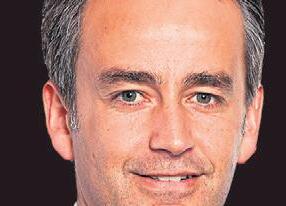
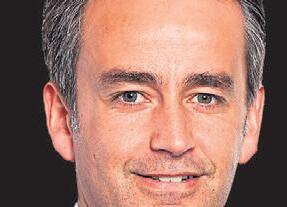
Despite some dramatic headlines in recent months, markets have continued to navigate a range of events with relative resilience.

Volatility has been a constant theme, yet the global market delivered healthy gains over the quarter.
Share markets have ticked higher on signs that inflation (whilst still far too high for central banks’ liking) has peaked and is starting to ease in most developed economies. Eco-

nomic activity across the world’s major economies has, so far, largely been better than expected.
While on the whole markets have had a constructive 2023 so far, we don’t expect plain sailing ahead. The chief uncertainty the market is grappling with remains the dynam-
ic between inflation, interest rates, and recession risk. Will inflation slow sufficiently for central banks to start reducing interest rates and allow the economy to touch down with a “soft landing”? Or will it be more of a thud, with central banks engendering a recession (maybe unintentionally) to bring inflation back to within target ranges? This isn’t an easy question to answer and the events of this year only add to the challenge.
Locally the Reserve Bank of New Zealand (RBNZ) has indicated that it has reached the end of interest rates hikes for this cycle. Inflation in New Zealand ran at a pace of 6.7% over the year to March 2023, but is expected to come back into the RBNZ’s target band (1–3%) by September 2024.

US debt ceiling debate
Recently the United States Government debt ceiling debate has replaced bank failures in the headlines.


Legislation puts a cap on the amount of debt the US Treasury can borrow and every time it is hit Congress needs to either agree to raise the ceiling or cut back spending. The US officially hit the debt ceiling on 19 January 2023.
An agreement between US President Biden and Republican House Speaker McCarthy was reached at the end of May, which has been approved by the House of Representatives and the Senate. The deal raises the US borrowing limit until 2025, when there’s little doubt the Democrats and Republicans will go through the same dance once again.
Move forward, but with caution

As we look out across the balance of the year we expect inflation to moderate, potentially “helped” by a soft, recessionary economy. The key questions are ones of magnitude. How sharply will inflation decline? How much will economies slow? And then, if they do slow significantly, what potential do central banks have to provide support through interest rate cuts?
It’s easy to want to hibernate and wait for the outlook to clear. The risk of doing so, though, is missing out on healthy periods like we’ve had over the past six or seven months. An often used mantra of investing great Howard Marks is, “move forward, but with caution”. What Howard means is: to stay invested but to do so with a bit more caution than usual.


This article was prepared as at 31 May 2023 and provides market commentary for the three-month period ending on that date. We appreciate that market volatility and economic uncertainty doesn’t make an easy backdrop for investors.
To discuss your investment options please contact Andrew Wyllie, who is an Investment Adviser and is Forsyth Barr’s Christchurch Branch Co-Manager. He can be contacted regarding portfolio management, fixed interest, or share investments on 0800 367 227 or andrew.wyllie@ forsythbarr.co.nz.









This column is general in nature, has been prepared in good faith based on information obtained from sources believed to be reliable and accurate, and should not be regarded as financial advice.





CANTERBURY FARMING RURAL PROFESSIONALS
Is farm subdivision on your horizon? Call us now for great subdivision advice. Call 0800 787 775 for a chat hello@survusrural.co.nz www.survusrural.co.nz Looking at off-farm investments? When you are thinking about your investment options, talk to Forsyth Barr To get personalised investment advice and portfolio management specific to your investing needs, talk to Investment Adviser Andrew Wyllie in confidence on (03) 365 4244 or email andrew.wyllie@forsythbarr.co.nz CHC6189-02March 2021
] with Andrew Wyllie ] Forsyth Barr
Proposed increase in income tax rate for trusts



Trusts have long been a popular method for individuals and families to


in New Zealand.
] with Brydie Dale ] Helmore



Stewart Lawyers
They are particularly favoured for estate planning across multiple generations for farming families in rural Canterbury.



While Trusts offer various benefits, including asset protection and estate planning advantages, it is essential to understand the reporting and tax implications associated with them.
Trusts are subject to income tax under the provisions of the Income Tax Act 2007. Trusts are considered separate entities for

tax purposes, meaning they are required to file tax returns and pay income tax on any income generated.
The Labour Government has released their 2023 budget in May this year, which proposes an increase on the Income Tax Rate for Trusts from 33% to 39%. This is a significant change which is due to take effect from 1 April 2024.
The increased Income Tax Rate, along with recently implemented reporting requirements for Trusts (which came into effect 1 April 2021), are part of the Governments attempt to keep a closer eye on Trusts and deter high income earners gaining a tax advantage by allocating income to a Trust.

Where the sole asset of the Trust is the family home, as will be the case with a number of Family Trusts, it is likely the Trust will not be generating income, and will not be required to pay any income tax. If this is the case, all that is required of trustees is to file a non-active trust declaration (IR633) with IRD. In this case the proposed 39% Income Tax Rate is unlikely to have an effect on the Trust.
Many Trusts in North Canterbury are used as vehicles for operating farms, which will




manage their wealth and assets
most likely result in the Trust having income generating assets. Trust income can include rental income, dividends, interest, capital gains, and other types of taxable income generated by the Trust.
Where the Trust generates an income of over $1,000, the trustees of the Trust will be required to file a tax return with the IRD, and from 1 April 2024, the Trust’s income will be taxed at the 39% Tax Rate. Although, as 2023 is an election year, we may see a change in Government, which could result in the proposed 39% income tax rate for Trusts not being implemented, in which case the current Income Tax Rate of 33% would apply.
If trustees are unsure whether their Trust may be generating income, and which reporting requirements apply to their Trust, we recommend they take advice from a chartered accountant.
In light of the recent Trust reporting requirements, and increase in the Income Tax
Rate for Trusts, it is a good time for trustees to be thinking about whether the Trust is still fit for purpose.
What may have been an effective asset planning strategy when the Trust was set up, may no longer be the best option under the current legislation. If trustees have any concerns regarding the structure of their Trust, they ought to speak to their lawyer.

CANTERBURY FARMING July 2023 5 RURAL PROFESSIONALS PROFESSIONAL RURAL REAL ESTATE ADVICE Residential / Commercial / Rural / Lifestyle Ben Turner 027 530 1400 03 375 4736 ben.turner@bayleys.co.nz WHALAN & PARTNERS LTD, BAYLEYS, LICENSED UNDER THE REA ACT 2008 Call Ben today for an altogether better approach to your rural real estate needs along with an up-to-date market overview.
‘It is a good time for trustees to be thinking about whether the Trust is still fit for purpose.











6 July 2023 CANTERBURY FARMING OFFER AVAILABLE FROM 1 APRIL TO 30 JUNE 2023 REAL WORLD TOUGH *FINANCE DISCLAIMER: Zero deposit; annual repayments only with first repayment due after 12 months and 6.95% p.a. fixed interest rate on a 24 or 36 month loan term. Asset backed commercial applicants only with NZBN registered for minimum of 1 year. Maximum amount financed is $35,000 and applies to AG125, AG200, TTR230/A, YFM350FA, YFM450FB, YFM450FB/P, YFM700FA, YFM700FB/P, YXC700P, YXE850P, YXF850, YXM700, YXE1000PSEM, YXF1000PSEM. Offer available from 1 April, 2023 till 30 June, 2023 with final settlement date of October 31, 2023. Credit criteria, fees, charges and conditions apply including an establishment fee of $325, $10 PPSR fee and a dealer administration fee. Finance to approved applicants by Yamaha Motor Finance New Zealand Ltd. (YMF) NZBN 9429036270798 FSP 9622. ^ Warranty cover is subject to a range of requirements including following the service schedule & applicable vehicle load/towing limits. Service Intervals are dependent on usage and environmental factors. www.yamaha-motor.co.nz FIND YOUR LOCAL DEALER AT: $4,608 EXC GST $15,086 EXC GST $26,782 EXC GST FINANCE AVAILABLE YAMAHA RELIABILITY YAMAHA SERVICE INTERVALS AG125 RIDE AWAY KODIAK 450 EPS RIDE AWAY WOLVERINE X2 UTILITY RIDE AWAY ZERO DEPOSIT ZERO REPAYMENTS FOR 12 MONTHS
Retire? Yes. Stop? No.
I seem to tell my own story a lot on these pages, but only because I think it applies to others as well.
] with Rob Cope
When I was knee high to a perching pullet, farmers and others retired at age 60 and were dead by 65. They had stopped.
Thankfully that scenario has opened out and people are living well into their 90’s, but as a funeral celebrant I am saddened by the number of men who have passed far too early.
A Rob Cope-Williams survey, about as scientific as estimating who will win the World Rugby cup, suggests that men who retire off the farm and come into the town are very susceptible to health problems.
Mowing a small lawn once a week doesn’t measure up as exercise.
Playing bowls seems a great idea, but seriously, while it is a great way to keep up with others socially, again the exercise flag appears very quickly.
If you are anything like me, walking around a park seems as exciting as reading a week old newspaper.
So, what options are there for chaps in our 70’s and beyond?

My cousin in South Canterbury came off the farm at an early age and his daughter who was watching him shovelling grain stopped him in his tracks by pointing out that when he stops doing physical work, he will lose his fitness, strength and probably get fat.
Aghast, John signed up for the local gym and has kept his fitness and strength, and probably hasn’t got fat.
My local gym has very few members and no gym bunnies with rippling muscles and flat tummies, and surprise, there are several elderly gentlemen who go regularly simply to keep in shape.
] with John Arts
Are you taking a joint supplement?
They say death and taxes are the only certainties; but osteoarthritis must be close to this list.
The sales of worldwide joint and bone supplements are a staggering US$11.7 billion and expected to grow by another 50% over the next 5 years.
The majority use joint supplements to treat joint problems, most for osteoarthritis, with about 40% of developing knee osteoarthritis alone. Pain is a great motivator and people turn to joint supplements for relief; but do they help?
There has been significant research into compounds found in joint supplements, especially glucosamine, chondroitin, and turmeric. It comes as no surprise that studies come to differing conclusions ranging from poor to excellent results.
While studies and research can be helpful, my criteria for assessing osteoarthritis supplements is simple. I assess the effectiveness of my supplements solely by whether they help. An important part of my discipline of nutritional medicine is regularly reviewing progress. When someone commences my joint supplements, I



contact them after 6 weeks, then again at 3 months to see how they are doing. The measure of assessment is again simple; is it working.
When someone purchases my joint products, I offer a joint health assessment which the majority adopt. I ask questions about the problem including its diagnosis and treatment including symptoms and a description of limitations in mobility. At the 6-weekly review we then compare progress to the initial assessment and modify the programme as needed.
One thing I can say for certain, if people do not get a tangible benefit, they will stop taking them. Results are my sole measure whether a supplement is helping.

John Arts (B.Soc.Sci, Dip Tch, Adv.Dip.Nut.Med) is a nutritional medicine practitioner and founder of Abundant Health ltd. For questions or advice contact John on 0800 423559 or email john@ abundant.co.nz. Join his newsletter at www. abundant.co.nz.






There is a saying that 70 is the new 50, and I live by that, mentally keep young, still eat and drink what you desire and travel regularly, you have deserved it, but please keep active.
As you know retired farmers stand out in any crowd. Normally dressed differently, usually slightly stooped from years of abusing their backs, and they have that farming walk.
But, on top of that there’s the look in their eye when they are in a supermarket, a look of being confined.




Next time you see an ex-farmer in the vege section, watch his reaction when he sees the price of a swede.


A strong message to our retired farmers families, “Don’t fence them in”.

CANTERBURY FARMING July 2023 7
HEALTH ON THE FARM Abundant Health New enhanced formula
‘
Next time you see an ex-farmer in the vege section, watch his reaction when he sees the price of a swede.
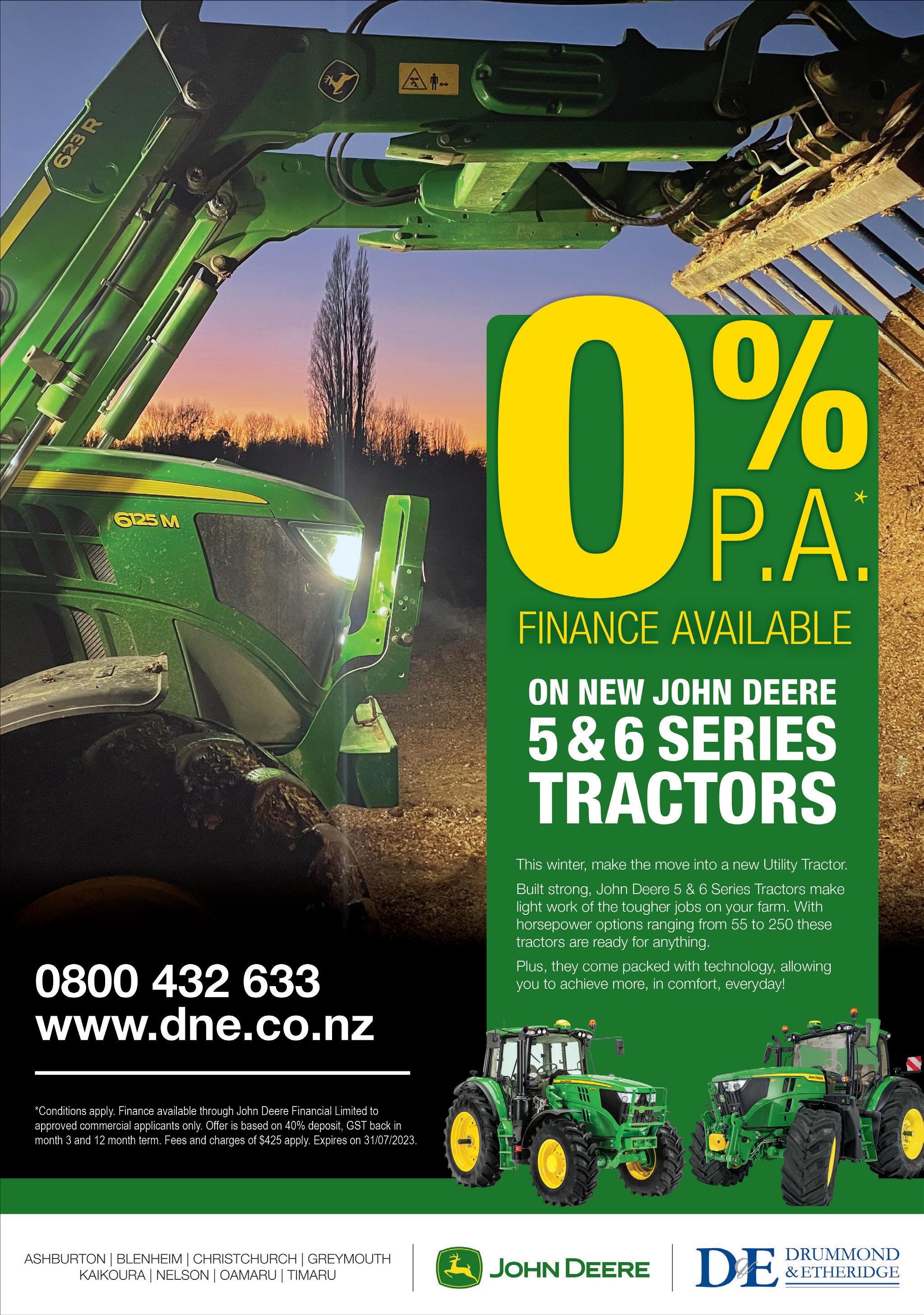
8 July 2023 CANTERBURY FARMING
John Deere dozer delivers
Article supplied by ] Drummond & Etheridge
Their technology-forward business features integrated design and contract management systems, GPS survey equipment, and the latest soil testing equipment. Taylors Contracting Co Ltd also boasts a communications network that covers over 130 machines, ensuring seamless coordination and efficiency.


A recent addition to the Taylors fleet is a John Deere 850L Crawler Dozer with factory forestry guarding, bought in to replace a J series Dozer with over 23,000 hours on it.
The John Deere 850L delivers more horsepower and torque than its predecessor, but for operator John ‘JB’ Brunsden the real revelation has been the transition from a bull blade on the J to the six-way blade on the 850L.
With the ability to move and push material at up to six different angles, the six-way blade offers maximum operator control. Being able to tilt the blade and angle it to the left or right means operators can contour their cut or spread, and move material with precision.
This versatility reduces the number of passes required and improves overall efficiency, helping to finish the job quicker, especially on uneven terrain.
“Everyone’s noticed the difference, I

think. Even the forest engineers,” says JB.
“Things happen a bit more efficiently. Putting benches in, that sort of thing, it’s just way ahead of the bull blade.”
JB, a long-time employee of Taylors, is currently in the process of modifying an old skid site in Pigeon Valley, Tasman. Putting benches around the edge and getting rid of all the rubbish onto the benches before lowering the whole skid site to make it bigger.
Job satisfaction, and great machinery is what keeps JB in his job.
“I came to work for Taylors about fifteen or sixteen years ago just to give them a hand, because I’d retired,” says JB.
“I wouldn’t even be doing this if I couldn’t have a John Deere. I don’t have to be here;


I’m doing it because I enjoy it.”
While the new dozer took some time to adjust to after spending so many hours in the previous one, JB says that it is doing everything he could want it to do and more. He is particularly impressed with its agility and technical features.

“This old fella has to get used to all the modern technology,” he jokes. “But it’s balance, efficiency, it’s just right up there. The maneuverability of the John Deere – there’s nothing that’ll touch it. Honestly, they’re just out on their own.”
Improved ripper controls and a comfortable cab are other key features identified by JB, as well as the blade-shake button, that when pressed causes the blade to shake repeatedly to help shed materials such as sticky soil from the blade.
“I’m actually falling in love all over again,” says JB

For more information on the range of John Deere Construction & Forestry equipment available from Drummond & Etheridge, contact your local branch on 0800 432 633, or visit www.dne.co.nz
For more information on the civil services offered by Taylors Contracting Co ltd, phone 03 542 3150, or visit www.taycon.co.nz
is limited on all
Nitrogen applied to pasture aids growth, but it can leach into the ground, lowering surface and groundwater quality. Reducing nitrogen use is essential for protecting drinking water and the environment.
The limit of 190kg per hectare per year for synthetic nitrogen fertiliser use applies to all grazed pasture, not just dairy. Canterbury dairy farmers: report your use to us by the end of July.
For access to the reporting tools, visit ecan.govt.nz/ncap, or call us on 0800 324 636.
CANTERBURY FARMING July 2023 9 E23/8308
Reducing
]
Synthetic nitrogen fertiliser use
grazed pasture.
your fertiliser use
Taylors Contracting Co Ltd is a leading civil engineering contracting company based in Brightwater, near Nelson, New Zealand, specialising in earthmoving, civil construction, forestry infrastructure, and quarry services throughout the South Island.
Improved performance: The John Deere 850l delivers more horsepower and torque than its predecessor, but for Taylors Contracting operator John ‘JB’ Brunsden the real revelation has been the transition from a bull blade on the J to the six-way blade on the 850l.





10 July 2023 CANTERBURY FARMING When you buy a Suzuki KingQuad, you’re getting more than 40 years of proven 4x4 performance and reliability. And right now you can divide the cost into 3 payments over 24 months at an interest rate of only 5.99%*. Talk to your participating Suzuki dealer today or visit Suzuki.co.nz 4x4÷3 IN 12 MONTHS IN 24 MONTHS DEPOSIT 1/3 1/3 1/3 + + * T&Cs. This offer is only available on new KingQuad models purchased from 1/6/23 – 31/8/23 through participating Suzuki dealers while stocks last. Finance offer is based on a 5.99% p.a. interest rate fixed over a 24-month loan term and on the following payments: an up-front deposit of one-third (1/3) of the RRP, the cost of any accessories fitted, and the fees set out below; a further payment of one-third (1/3) of the RRP to be paid on the 12-month loan anniversary; and a final payment of one-third (1/3) of the RRP to be paid on the 24-month loan anniversary. The 5.99% p.a. interest is fixed for the term of the loan. A PPSR fee of $10.35, a monthly maintenance fee of $2, a UDC loan fee of $105 and a dealer origination fee will apply (your dealer can tell you their applicable fee). The loan is provided by UDC Finance Limited. UDC Finance Limited’s lending criteria, standard terms and conditions apply. This offer cannot be used in conjunction with any other discounts or offers. TRACTA65841_KINGQUAD_ATV_CF
Standing the test of time
Suzuki ATV have been on the farm since the early 1980’s and believe or not it’s been 40 years since the first Suzuki LT125 arrived in New Zealand.
] by Simon Meade
General Manager Suzuki NZ

Motorcycle & Marine
Farmers were quick to spot a winning idea and it didn’t take long for three-wheelers and farm bikes to be replaced with the more practical transport solution offered by an ATV.

For 2023 Suzuki have stepped up as one of the market leaders offering a factory backed three year 15,000km warranty on all Suzuki KingQuad 400cc to 750cc.
Sales manager for Suzuki New Zealand Richard Williams was quick to point out that Suzuki’s confidence in the build quality, and Japanese controlled production processes, meant that the evolution of KingQuad as a brand and product deserves the recognition of a three year warranty period.
“Nothing makes more sense than giving our customers the same confidence in Suzuki as we have ourselves,” Williams said.
What sets Suzuki apart from most of the competitors is a solid determination to build ATV that work on New Zealand farms.
All of the latest generation of Suzuki ATV have been prototype tested here by Japanese engineers, this experience added to the 40 previous years of learning means that the latest ATV are in fact the greatest so far.
Times are changing and whilst there are few clinging to old school manual gearboxes, once you’ve ridden an automatic ATV it’s very difficult to go back.
The CVT system, which stands for constantly variable transmission, is perfect for all day farming, providing downhill engine braking like a manual shift would, and when it comes to acceleration the CVT system keeps the engine in the most powerful torque range. Reliable and low maintenance CVT transmission has been used by Suzuki for over 25 years and proven themselves across a range of products including motorcycles and automobiles.
Like CVT transmission, ATV suspension has also had to develop to accommodate rider expectation and you’ll find comfort levels have improved dramatically making long days in the saddle a much more enjoya-
ble experience. Other rider features include digital dash, selectable 4WD and full size footboards, and mudguard over-fenders for ultimate mud protection. On the 500 and 750 there is also the option of power steering which significantly reduces rider fatigue.
If you’re currently finding your ATV hard
THAT’S HOW WE ROLL
• 60mm CRMO4v-steel shafts with rubber suspended bearings


• Hydraulic cracker board with parallelogram eliminates lumping in fields.

• Hydraulic weight distribution system provides 100% even compaction of soil.

• Comes in working widths from 5.3m-12.3m

riding and its looking a little worse for wear then Suzuki’s current 1/3 + 1/3 + 1/3 offer could be just the ticket. With 5.99% finance and 24 months to pay it makes sense to call your local Suzuki dealer for a demo ride, take it from me, you won’t be disappointed.
Ultimate seedbed prep

The high capacity Rollomaximum is a precise seed bed cultivator with built-in front and rear rollers. The combination of rollers and cultivator tines regularly achieves a seed bed in a single pass with the change to and from transport is done hydraulically from a stationary position roller.


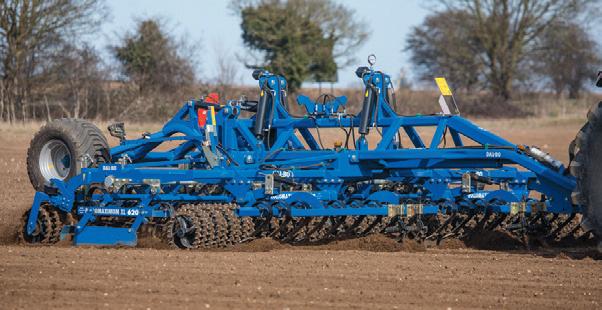

Comes in working widths from 6.2m – 12.4m.





























CANTERBURY FARMING July 2023 11 Call Alastair Robertson | 027 435 2642 AMBERLEY | LEESTON | ASHBURTON | TIMARU | OAMARU
the
www.cochranes.co.nz
CALL US ABOUT MODELS DEMO Maxiroll Rollomaximum #1 Selling roller in
UK
]
]
Point of difference: What sets Suzuki apart from most of the competitors is a solid determination to build ATV that work on New Zealand farms.

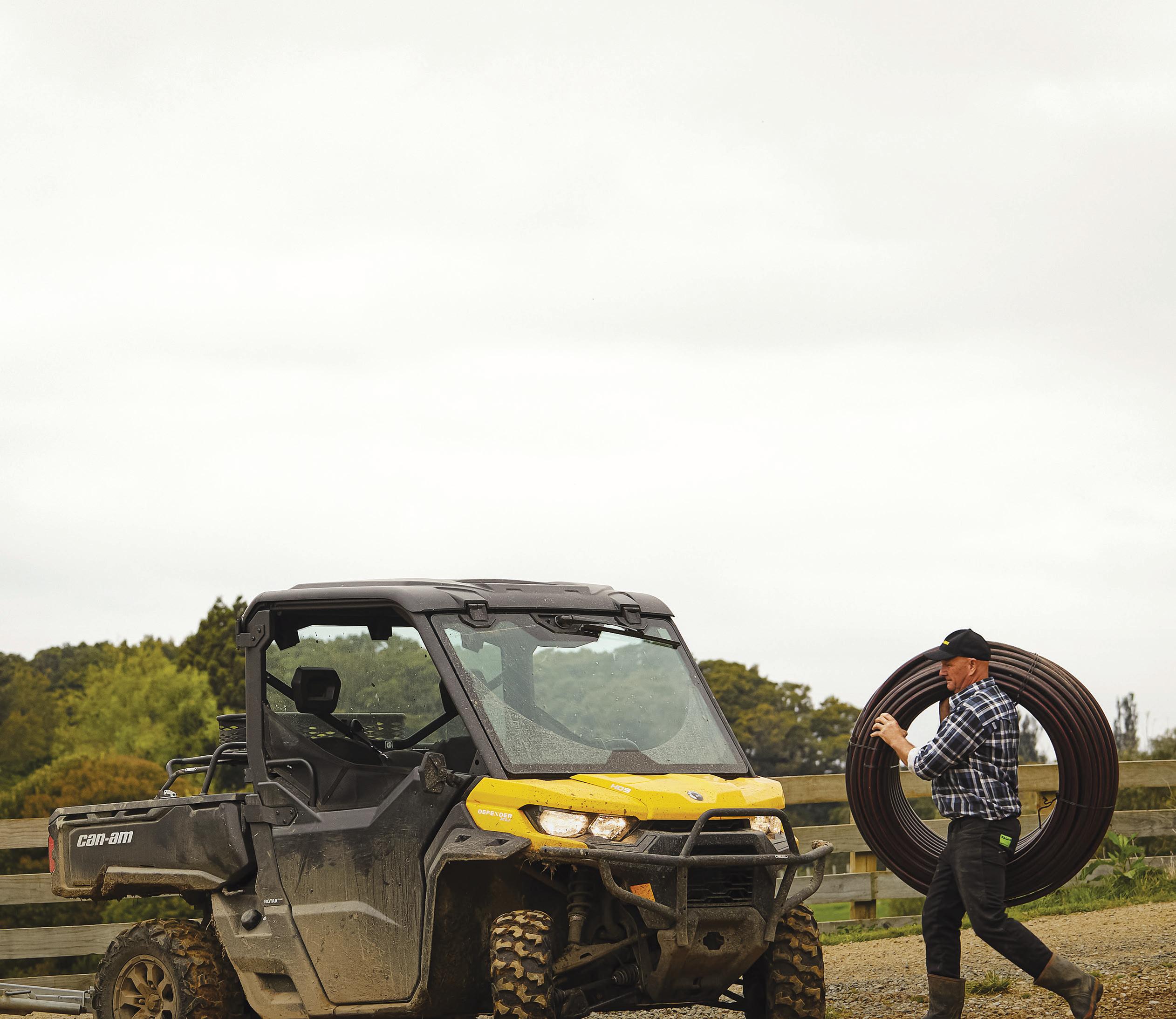




12 July 2023 CANTERBURY FARMING
Meet the Canterbury rural team

Our proven Canterbury rural team, know what’s required to maximise results. If you are considering taking your property to market this spring and want a confidential chat around your next move, give our Canterbury Rural Manager Gareth Cox a call on 021 250 9714 to connect with one of our team or visit pb.co.nz



CANTERBURY FARMING July 2023 13
Scan the QR code to see a video introducing the team
Property Brokers Ltd Licensed REAA 2008 PB068400 pb.co.nz
Single
















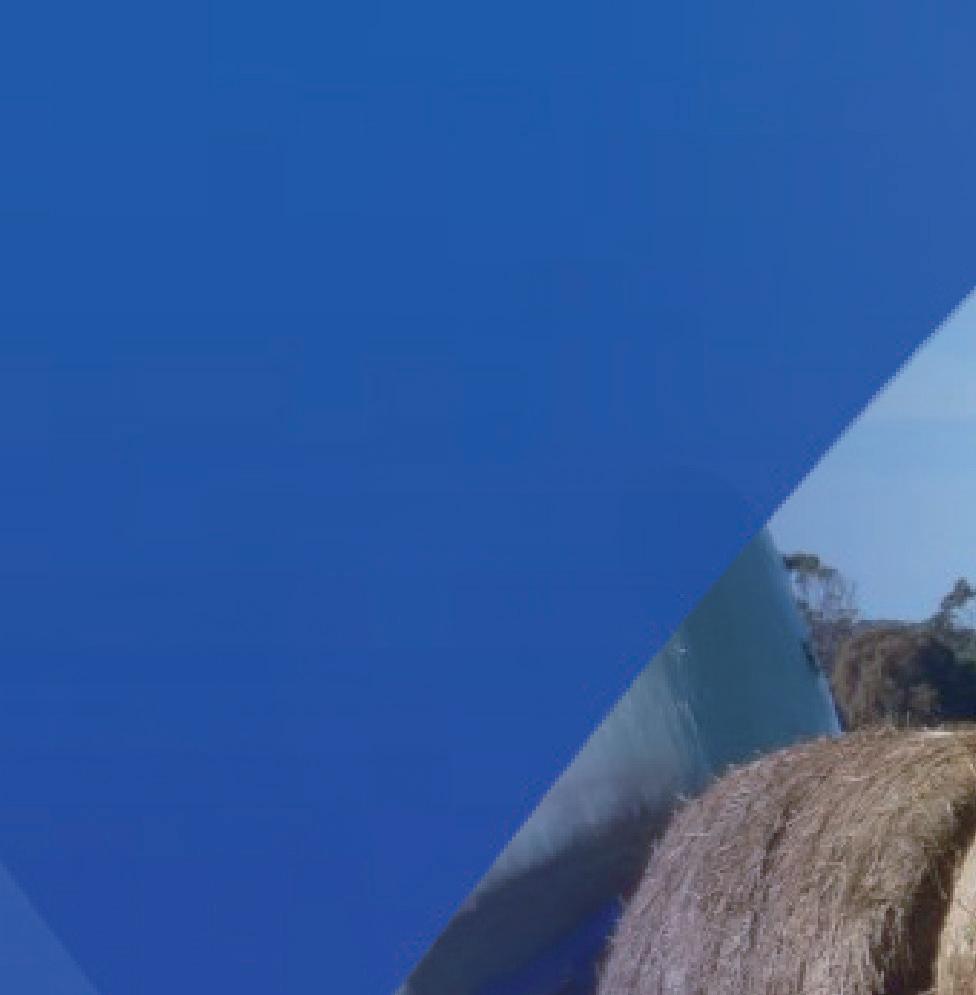

































McIntosh gear is New Zealand made specifically for our tough conditions and operators. Heavy duty components make sure that their gear lasts longer and performs better. They have now teamed together with Power farming Canterbury to offer local farmers not only the best gear available but also the best service available. If you are looking for excellent quality and great support give us a call to see how McIntosh can make your life easier.












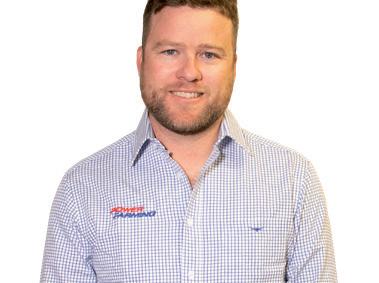




14 July 2023 CANTERBURY FARMING Jimmy Leigh Sales 027 405 6941 Geoff McCabe Dealer Principal 021 220 9544 Power Farming Canterbury | 1 George Holmes Rd, Rolleston Terms, conditions and lending criteria apply, 0% Finance 1/3 deposit or trade, 1/3 in six months and 1/3 in twelve months. Offer ends June 30th. Joel Parris Sales 027 435 0884
Canterbury
McIntosh chooses new partner in
Bale Feeder Heavy duty 1 ¼” drive motors for long life 8 tooth drive sprockets and 3” 12,000lb roller chain to last longer Larger deep and wide cradle for better bale retainment Optional square bale kit and trough extensions available Multi Bale Feeder • Choose from either 4 or 5 bale feeders • Same heavy duty components as the two units above • Feed out either side from the wide cradle Proven long lasting design Kiwi built trailers from 4.5 ton to 20t Larger tyres for better floatation 5mm corten or 40mm Plenty of options available to increase uses Sizes from 7.8cbm to 27.2cbm Choose from heavy duty Multicrop or extra heavy duty Titan models Up to 13mm floor and elevator chains with larger sprockets All designed with years of experience to trouble free operation and minimal maintenance
Bale Feeder Same heavy duty components as single bale feeder Wide 2300mm cradle to get feed away from the tyres Weighs an impressive 1100kg to last longer Square bale options available • timber decks, stronger decks to last longer 0% INTEREST * 1/3RD IN 6 MONTHS 1/3RD DEPOSIT NOW 1/3RD IN 12 MONTHS Take advantage of our McIntosh finance deal today!
Double
Marking 65 years of machinery supply


JJ Limited Tractor Dealership, a respected name in the agricultural machinery industry, is excited to celebrate its 65th anniversary in business.

]Article supplied by JJ Ltd
Established in 1958 the family-owned dealership has been providing farmers with Massey Ferguson, other AGCO branded products and exceptional service for over six decades.

In conjunction with this milestone, JJ Limited has announced the opening of a new branch, expanding its reach and reinforcing its commitment to serving farmers with excellence.
Throughout its illustrious history, the JJ Limited Tractor Dealership has been synonymous with reliability, expertise, and outstanding customer support.
Now, 65 years after opening and offering a wide range of high-quality products and services, the company is excited to celebrate this significant milestone and share its growth plans for the future. Over the past six plus decades, JJ Limited has established itself as a reliable and customer-focused company, providing farmers with innovative solutions to meet their evolving needs.
As a family-owned business, JJ Limited has nurtured long-lasting relationships with customers, delivering, and maintaining a strong commitment to excellence. The com-
pany’s success can be attributed to its core value of making everything they do personal with a customer-first approach.
“We are thrilled to celebrate 65 years of serving the agricultural community,” said Paul Jones, Managing Director and third generation leader at JJ Limited.
“Our success is a testament to the hard work and dedication of our teams, as well as the trust and support we have received from our customers over the years. We are excited about the future and remain committed to delivering exceptional products and services that empower farmers.”
With a reputation for carrying top brands in the industry, JJ Limited remains committed to offering a wide selection of tractors and implements that meet the varying needs and requirements of farmers.

The dealership proudly represents renowned brands such as Massey Ferguson, Fendt, and other leading manufacturers, ensuring that farmers have access to the latest technological advancements and reliable machinery to optimize their productivity

Looking ahead, JJ Limited is focused on expanding its product portfolio and enhancing its service offerings.
“Opening a new branch in Cromwell is





an exciting development for us, as it allows us to better serve our valued customers and extend our reach to new farming communities in the Queenstown and Lakes districts.”
The new branch is strategically positioned to provide farmers in the surrounding areas with easy access to a comprehensive range of tractors and agricultural machinery. The expansion will enable the dealership to accommodate the growing demand for high-quality equipment, and servicing further strengthening its position as a preferred choice for farmers in the region.
As JJ Limited embarks on the next chapter of its journey, it remains committed to its core values and its mission of delivering excellence in the agriculture industry. With the support of leading brands from AGCO, Origin AG and others, JJ Limited is well-po-
All in the family: JJ limited is a family owned business now into its third generation with brothers Grant (left) and Paul Jones current directors.
sitioned to continue its growth and make a positive impact on the farming community for many more years to come.

For more information about JJ limited and its range of products, including Massey Ferguson and Fendt, please visit www jj.co.nz

DRIVING LOCAL FARMERS SINCE 1958 BOOK AN 8S DEMO NOW AT JJ'S CHRISTCHURCH
NEW MF 8S SERIES 205 – 305 HP
NEW CAB ENVIRONMENT - The quietest cab on the market offering 360° visibility
NEW DYNA-7 AND DYNA VT TRANSMISSIONS25% increased efficiency and 5% better fuel economy
Engine Efficiency- max power and torque at low engine revs cuts fuel consumption by 10% and reduces noise level
100% CONNECTED - Comes with free 5 year MF Connect telemetry subscription and optional precision farming suite
JJ LTD CHRISTCHURCH
Henry Williams 027 260 7821 henry williams@jj co nz jj co nz
CANTERBURY FARMING July 2023 15
The beginning: JJ limited Tractor Dealership’s original staff at the company’s opening in 1958.
Looking after your tractor for a long life

Tractors are essential pieces of farm equipment, and with the right maintenance they can run for years with very little trouble.
] by Kent Caddick



Because there are so many different kinds of tractors with specific applications, maintenance may vary greatly from tractor to tractor. However, there are certain universal things you can do to help guarantee a long

and useful life for your tractor, and carrying out regular inspections is a key.







Familiarize yourself with your tractor’s manual


There are many different types of tractors on the market with a wide variety of applications and associated accessories. To be sure you properly maintain your specific make and model of tractor, you should read through the manual that came with it.
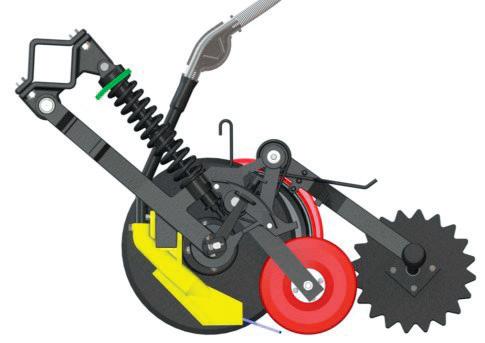

Many tractors require specific types of lubricants and hydraulic fluids that you can identify in the manual. If you do not have a manual for your tractor, you may be able to find the information on the manufacturer’s website.
Give the tractor a visual inspection
Before you get started with any planned maintenance on your tractor, give the whole thing a good once over to see if anything looks overly worn, broken, or dirty.

Many newer model tractors even have plastic win-















dows on fluid reservoirs to check things like hydraulic fluid levels.






Give your tractor a visual inspection before and after each use. Make note of any issues you identify to make sure you address them before the next time you use the tractor.
Do a tyre pressure check

Tractor tyres can last years, but operating a tractor with under-inflated tyres can ruin the sidewall and cause the tyres to wear faster than they should. Under-inflated tyres will also cause the tractor to burn more fuel in normal operations.


You may want to adjust tyre pressure for different types of jobs. For instance, if you plan on driving your tractor on the road, you might want to add a few more pounds of air.
Tyres lose pressure more quickly when temperatures change from cold to hot, so you may want to check your tyre pressure more frequently in the Spring and Autumn.
Inspect the belts and hoses
Just like in a car, a tractor’s engine relies on a number of rubber hoses and usually at least one belt. Look all the rubber components over for signs of wear or damage. Excessively worn rubber components should all be replaced. Look for grazing on the sides and bottom of any belts that may indicate that it’s been slipping. Any rubber that has cracked should be replaced.

Replace the air filter as needed









































Depending on the environment you use your tractor in, you may need to change your air filter more or less frequently. Locate the air filter using the tractor’s user manual, then visually inspect it. If it’s really dirty, it should be replaced.
There’s no real rule of thumb with air filters; they should just be replaced as they appear dirty.
You should check your air filter after eight hours of use or so.
16 July 2023 CANTERBURY FARMING www.agspares.co.nz TRACTOR PARTS NEW & USED HIGH QUALITY NEW PARTS FOR MOST TRACTOR MAKES & MODELS PLUS THOUSANDS OF USED PARTS FOR MOST TRACTOR MAKES & MODELS ORDER ONLINE FOR FREE FREIGHT. T&C’S APPLY HYDRAULICS LINKAGES SEATING PTO SHAFTS & PARTS ELECTRICAL AGRICULTURAL GEARBOXES REAR AXLE & TRANSMISSION Over 60 engines Late model, low hours Most major brands TRACTOR PARTS & DISMANTLING Needham Ag JD750a Seeder parts Pivot rebuild kits Bonilla seed tabs, Seed boot mounting repair kits
Boots, Discs, V8 firming wheels, HD gauge wheels and Martin closing wheels •Maize Planter No -till hardware, Clutches and Controllers
Shop at our online store! 0275 083 789 unearthag.com MACHINERY
&
have the tools to be efficient, so you can get on and spend your time where its more important & effective. www allagri co nz Blair 027 333 6616 Terry 027 344 6616
•
SALES
CONSULTANTS We
Check list: No matter what size a tractor is regular maintenance will extend its life. Photo supplied by Drummond &
Etheridge
Glyphosate decisions based on politics

All eyes are on the European Commission as it deliberates over a decision to ban one of the most important agricultural innovations of our time as the use of glyphosate in European countries reaches a crossroads with the re-authorisation of glyphosate expiring this year.
] by Mark Ross
Chief executive of Animal
and Plant Health NZ
As the decision looms, farmers fear that a ban on glyphosate would see their crops taken over by deep-rooted weeds and suffer quality losses, alongside a reduction in farm productivity and food security. Environmentalists are concerned about increased carbon emissions and a detriment to soil health and erosion.
The European Food Safety Authority (EFSA) – which issues advice on existing and emerging food risks, to inform European laws, rules and policymaking – postponed making a final scientific opinion on the re-evaluation of glyphosate until July 2023.
At the centre of the decision is whether the weedkiller is carcinogenic. The European Chemicals Agency Risk Assessment Committee concluded, in May 2022, that classifying glyphosate as a carcinogen was not justified. The committee found that the available scientific evidence did not meet the criteria to classify glyphosate for specific target organ toxicity or as a mutagenic or reprotoxic substance. This finding will feed into a risk assessment by the EFSA – which will assess all possible risks that exposure to glyphosate might pose to humans, animals and the environment.
The European Commission will then ana-





lyse the conclusions, before issuing a renewal report and a draft regulation on whether glyphosate can be approved for use. Further discussions will take place ahead of a vote by the Member States on the Commission’s proposal.
In New Zealand, the Environmental Protection Authority is also deciding whether to reassess glyphosate, following a report it released last year in response to its call for information on the world’s most widely used herbicide. Keeping farming on tenterhooks, it is likely waiting on the European decision before making its own decision on a reassessment.



Any changes to the regulation of agricultural chemicals in Europe will result in critical crop protection tools and associated import tolerances being unnecessarily withdrawn from the European market, severely impacting trade.
If such a precedent is followed in New Zealand, farmers would be forced to switch to less effective techniques and resort to old destructive, labour-intensive, and counter-intuitive practices like tillage.


Tillage fractures the soil, disrupting soil structure, leading to soil erosion, and releasing greenhouse gases into the atmosphere. It
also reduces crop residue, which helps cushion the force of pounding raindrops. Without soil residue, particles become more easily dislodged and can be moved or ‘splashed’ away, allowing run off into nearby streams, gullies and rivers. Sediment turns the water brown and is eventually released into the sea, affecting sea life.


Contradicting current environmental goals is the contribution that tillage makes to climate change. Plants absorb carbon dioxide from the atmosphere through photosynthesis and pass carbon to the ground when dead roots and leaves decompose. Tillage releases this carbon from the soil to the atmosphere, contributing to global warming.

The dramatic dichotomy between global scientific consensus and public policy and regulation has sparked global apprehension about what comes next for global food security and the possible return to a bygone era.
While there will be a scientific discussion, the ultimate decision on whether to re-authorise glyphosate –and for how long – will likely be a political one.
CANTERBURY FARMING July 2023 17 Property | Family | Wills Trusts | Estates | EPAs | Rural Business | Traffic | Employment Leeston (03) 324 3033 Email: lawyers@anglands.co.nz | www.anglands.co.nz Solicitors of Selwyn since 1965
Ronald W. Angland & Son LAWYERS
]
]
‘
The dramatic dichotomy between global scientific consensus and public policy and regulation has sparked global apprehension about what comes next for global food security and the possible return to a bygone era.
Keeping the grass green


It’s no good just looking from the kitchen window and deciding that if the paddocks look green, all is well.


] by Kent Caddick

Pasture has to be long enough for stock to graze, and for cattle this means at least 10cm high.
Unlike horses with both top and bottom teeth allowing them to nibble, cattle are unable to do that, and if they are forced to try, they end up wearing away their bottom teeth and eating large amounts of soil which is bad for digestion.
Sheep can eat much shorter pasture but need enough to prevent them having to eat down to soil level too.
The main issues with late autumn and early winter pasture is feed ‘quality’ and not just feed ‘quantity’. Lush green pasture is low in Dry Matter (DM) so has a high water content, it’s high in protein and energy, but very low in fibre which is important for good rumen digestion. So it’s a very unbalanced feed hence the need for supplements.
With hard frosts in the South Island, growth rates per day can be zero. So this means the deficit has to be made up totally with good quality supplements, so the ‘condition’ of your stock is the best guide to their health and future performance.

The individual feeding needs of different stock will vary over time, and there are tables to provide these data or talk to a consultant or farmer who does regular feed budgets.
Strategic use of nitrogen is always recommended to boost pasture production, but you need to have a good ryegrass content in the pasture and the 10cm soil temperature needs to be above 6degC, and the ground is not waterlogged.

Nitrogen fertiliser such as urea is cheap to buy and easy to apply as it’s in granulated form, but with so much concern now for the environment, be careful to keep the spreader well clear of creeks and wet parts of the paddock, and it’s also better to apply a number of small dressings of under 20kg N/ha rather than in one large dollop.

The biggest sin anyone can commit on a farm or lifestyle block is to damage the delicate soil structure. Dig a few spade spits and examine it carefully seeing how deep the tiny root filaments grow down to, and how many worms there are. Smell the soil too which should be a very pleasant aroma.
So at all costs avoid pugging the soil, as there’s no point in seeing the highly-nutritious spring pasture grown at considerable expense, being pushed down into the soil by animals although sheep are generally not a problem.

Get a soil test done if there hasn’t been one done for over a year. It’s an ideal time of year to get your lime applications completed. Avoid putting stock to graze on paddocks where fertiliser has been newly applied. Fer-
tiliser needs rain to wash it off the leaves. Weeds never give up so if you had a bad weed problem last season, start working on it now to get the timing right. Timing of weed
spraying is the key, so you have to be able to recognise weeds in the early vegetative stages, long before flowering or seed heads appear in summer.

18 July 2023 CANTERBURY FARMING
Pasture perfect: Just because the grass is green doesn’t mean all is well on the lifestyle block.
Livestock appreciate shelter from bad weather
With winter setting in keeping your lifestyle block animals warm and secure is a priority.

 ] by Kent Caddick
] by Kent Caddick


Livestock can usually cope fairly well with either rain or wind or cold temperatures but when two or more of these conditions occur together, livestock can quickly become chilled.


If they get so cold that they shiver, their requirement for feed increases hugely, and if they don’t get extra feed they soon lose weight.
The animals that really need shelter are the old and the young, the newly-shorn and the fine-skinned, those in thin body condition and those that are not well.

This is true whatever the species - horses, ponies, cattle, sheep, deer, goats or alpacas.
Goats are particularly susceptible to cold because they have little fat under the skin and their coat is not waterproof. Tethered goats should always have access to a weatherproof shelter with solid roof and walls.
Horses need shelter from cold wet windy weather and appreciate a cover in winter. Covers should be waterproof and fitted correctly so that they don’t chafe. The horse’s skin and body condition under the cover

should be checked frequently.
Newborn animals are very vulnerable to bad weather and the odds are stacked against their survival when they are exposed to bad weather.
Rain, wind and cold temperatures together make a lethal combination and providing pregnant livestock with good shelter around the time of birth is like taking out an insurance policy. With effective shelter, the odds of the newborns surviving are improved hugely.
Lamb covers can provide useful protection from wet windy weather but the covers must fit comfortably and they shouldn’t flap or rustle to frighten the mother. Monitor closely lambs with covers on to make sure they don’t get tangled.
Winter is a good time to plant trees and shrubs to provide effective shelter and shade for years to come.
There are many and varied types of shelter plant from low dense flax to native bush, from conifers like macrocarpa and pine to deciduous poplars and willows.



Because an effective shelter belt of trees and shrubs takes years to establish, you can put up temporary shelter, especially in pad-

Chilly: Goats are particularly susceptible to cold because they have little fat under the skin and their coat is not waterproof.

docks where there are very young animals or newly shorn animals.
Wind netting secured tightly to the fence on the windward side of the paddock can be effective.
If you are storing big bales of hay or
baleage, they could be lined up close to but outside the fence.
Arranging bales of hay in the paddock in pairs in a V-shape angled into the prevailing wind provides good shelter for smaller grazing animals.

CANTERBURY FARMING July 2023 19 Pole Sheds & Hybrid Pole Sheds! Hybrid sheds mix timber and steel components. 9.0 wide bays no problems! Clear span no issues! Selw yn 15 Station Street, Leeston 7632 Phone: 03 324 3385 Email:info@buildlinkselwyn.co.nz 133A King Street, Kensington 7910 Phone: 03 688 4944 Selw yn Timaru Email:timaru@buildlink.co.nz www.buildlinkselwyn.co.nz www.buildlinktimaru.co.nz
A beginner’s guide to shearing sheep

With winter reaching its mid-point many lifestyle block owners who have a paddock of sheep will be turning their attention to the spring needs of their animals.


] by Kent Caddick



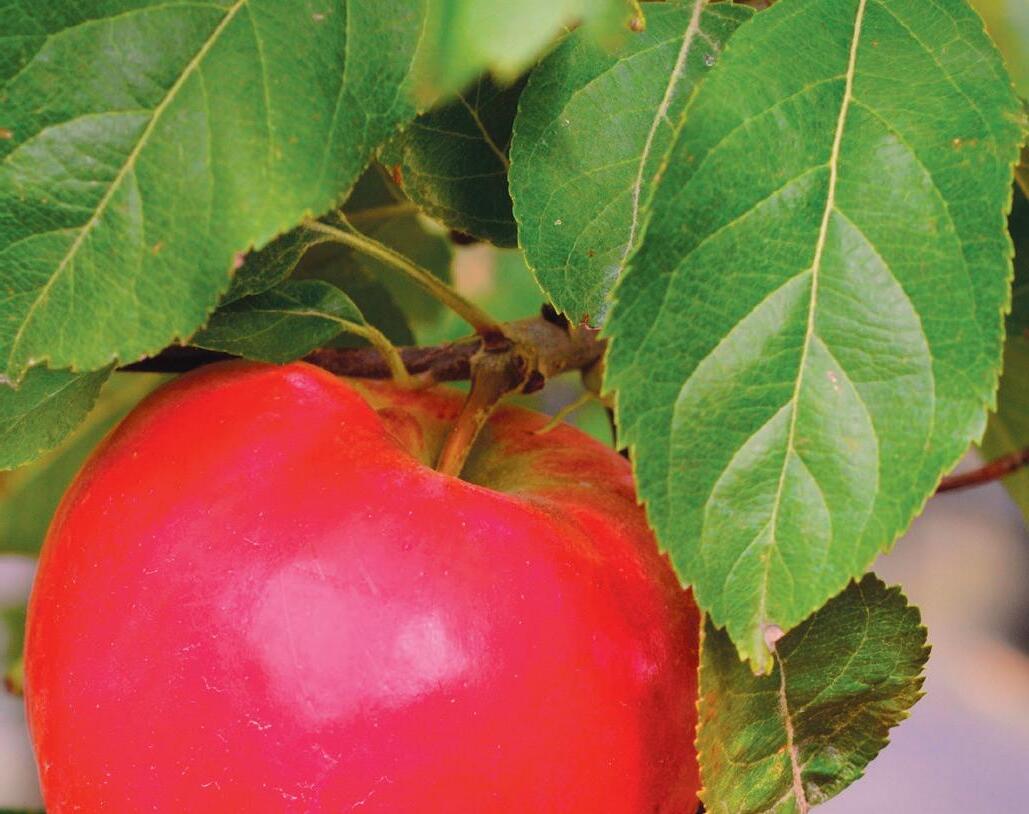
Sheep grow wool continuously, so it is important to shear them at least once a year. Shearing is generally carried out in spring, so that sheep don’t get overheated during summer.
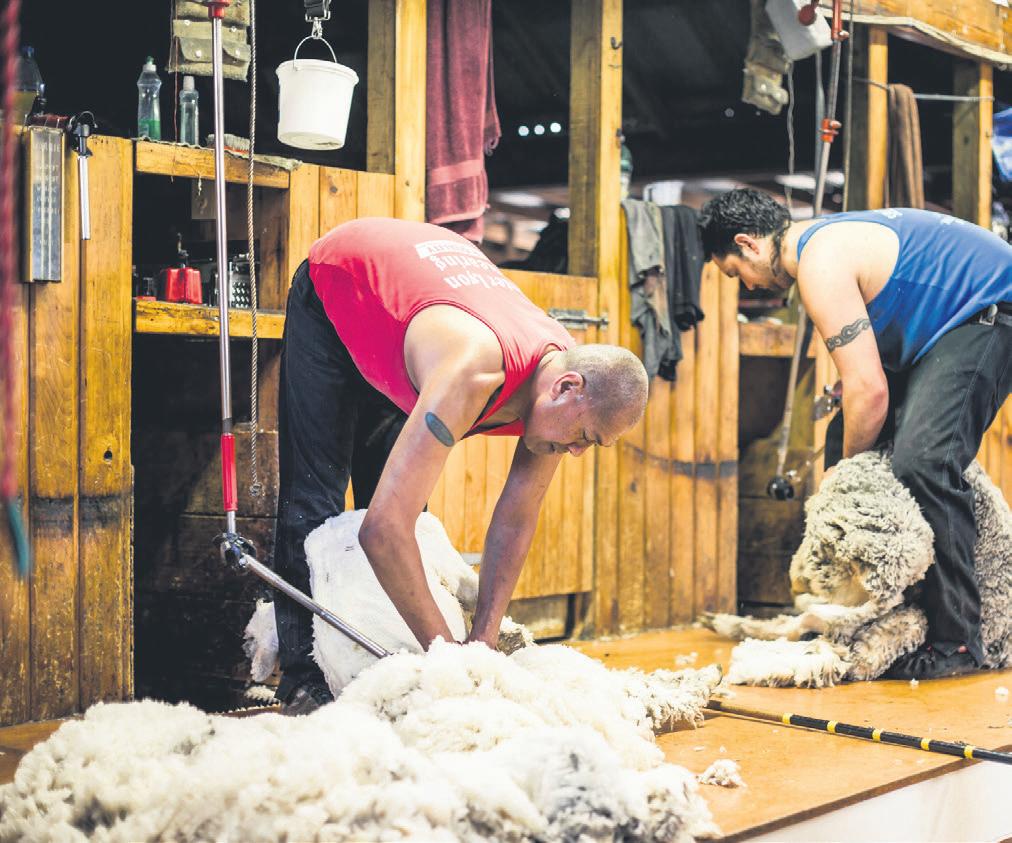
If a sheep is not shorn, its fleece becomes so bulky that it has difficulty moving around. The fleece can get water logged, and the sheep can become cast and unable to right itself. Also a long fleece is particularly likely to get daggy and soiled, making the sheep very susceptible to flystrike.
In very hot weather, sheep carrying too much wool will get heat stressed, and this is even more likely if the sheep is very fat.
When preparing for shearing don’t use any insecticide chemicals on the fleece for six weeks before shearing. When using chemicals on the wool, check the withholding times.
If sheep are dirty, prepare for shearing by having them crutched and dagged (ie remove dirty wool from the belly, and from below and around the tail).
Make sure the sheep are completely dry before shearing, otherwise cuts are more likely to become infected and the damp wool

will heat and get mouldy when stored. Shearers will refuse to shear wet sheep as it can cause skin infections and boils. To prevent damage to the shears and the sheep, warn the shearers if the sheep have large ear tags (plastic or brass). Make sure shearers are aware of any wethers among the ewes.
Hire skilled shearers shear your sheep. Keep your sheep in yards overnight, preferably under cover, so their stomachs and intestines empty out a bit and so they remain dry even if it rains in the night. Don’t pack them in too tightly or they will dung on each other’s wool.

Because newly shorn sheep feel the cold, put them in paddocks with windbreaks and plenty of pasture after shearing. It may take six weeks for the fleece to regrow sufficiently to provide effective insulation. If you don’t have good shelter for your shorn sheep, or if you are shearing them in winter, ask the shearer to use winter combs. These leave a short layer of wool to help protect sheep from cold weather.
Sheep need extra feed after shearing. If there is insufficient pasture, step up the supplementary feed. The best time to apply louse and flystrike prevention treatments is after shearing, while the wool is short.
Thinking ahead: Shearing your sheep in spring will help them not to remain cool over summer.


20 July 2023 CANTERBURY FARMING 1002 Robinsons Road - Between Templeton & Rolleston 0800 800 352 southernwoods.nz Visit our great plant centre - Open 7 days Established in 1987, Southern Woods has been growing millions of quality plants for over a generation. Talk to our knowledgeable team about fruit trees for your next project. - New Zealand Natives - Specimen Trees - Landscaping Plants - Ornamentals - Free Expert Advice - Delivery Nationwide A great time to plant fruit trees. Over 75 varieties of pipfruit and stonefruit available now.
Driveways
Earthquake Repairs
New Home Specialists
Patios & Paths
•
•
•
•
We need your help as much as you need ours Canterbury West Coast Air Rescue Trust. PO Box 20262, Christchurch 8543
Export log price hits eight year low

A memorable time for all the wrong reasons this month, with export log price at wharf gate falling to a low last experienced in 2015.
] with Allan laurie MNZIF ] Laurie Forestry Ltd



A check back on the related historical data in 2015 tells me for a project 100km from the port the cost of harvesting the trees and getting the resulting logs to the port came to about $65 per cubic metre. In 2023 those same elements cost about $80 per cubic metre.



I doubt you will need your abacus to work out if the current log price for the market indicator A grade is $75 per cubic metre and it cost $80 to get it there, what most logging crews and transport companies are doing right now. You guessed it folks, an unpaid holiday.!

Underpinning the current dire situation is pure and simple, a lack of demand in China. Here I must jump to the defence of our critical important China partners. I hear some Kiwis saying things like “there you go, they have done it again, China playing the market and trying to rule the world”.
These sorts of comments display an appalling lack of understanding, in this case of the softwood log trade. I repeat here, as I have done so in prior reports, NZ dominates this market current running at about 80% of all softwood log deliveries to the China eastern seaboard.
Thus, when NZ Log exporters push prices, and therefore volume’s higher in China when the fundamentals are displaying weakness,

the very obvious occurs, in this case it could be seen well ahead of the inevitable.



More concerning than has been the case when this has happened before, is little sign of a correction. In fact, many commentators are saying it could be August before any level of recovery as it could take that long before the volumes being shipped to China slow down enough to see a confidence swing.
NZ production is staying up there nationally due primarily to central North Island wind damage recovery and for many corporates the current low-price levels appear not to be low enough to get their attention. It is also fair to say many of the larger forest owners have solid supply agreements with local sawmills so need to keep that end of the bargain going.

In China, as at mid-June, the softwood inventory is 4.4 million and daily consumption is running at about 55,000m3 per day. Neither in themselves are alarming but more of the same old and the negative sentiment prevails.
We also do not see the China Government chipping in with construction sector stimulus packages as has happened of the last 10 years. I do not see a “rule the world policy” in amongst that, just simply a function of there being enough houses being built to meet current and future demand.

The double whammy here is the demand for lumber in both NZ and China is off the boil we have become used to. NZ sawmills are

certainly feeling the blunt end of the NZ Government’s “lets curb inflation” tool called interest rates.








This poorly applied seemingly only tool in the box, has slowed new house starts as well as pretty much everything else to that resembling a snail on a go slow.
One wonders when the finance minister is going to look at his balance of payments bottom line and realise the oops. I suspect there will need to be a trip to Spec Savers before that happens.
Of some shining lights out there or shall we say beacons of hope, it looks like shipping companies are coming to heal with most
commentators suggesting rates are coming off quickly for July fixtures. They will need to plummet before we see the skidders, excavators and logging trucks back at work.
Great to see lots of new planting going on and in our company case across land farmers do not see as a pastoral continuance. Great also to see lots of natives, water way protection planting and alternative exotic species in the planting mix. Long may it continue.
As always people, please remember the thoroughly important message, “it remains, as always, fundamentally important, the only way forward for climate, country and the planet, is to get out there and plant more trees”.

CANTERBURY FARMING July 2023 21 FORESTRY & LOGGING Forest Management LTD
Woodlot and shelterbelt harvesting
Timber sales to domestic and export markets
Forest
of
and greenfield sites
Forest valuation
Scheme
and management
With 25 years experience in the industry, the Forest Management Team offer services in: •
•
•
establishment
harvested
•
• Emission Trading
advice
units
• Trainer/Assessor in NZQA forestry related
to
in
of
find out more call us on 03 343 4101
visit www.forestmanagement.co.nz Office: Phone 03 359 5000 Email: admin@laurieforestry.co.nz Unit 3 337 Harewood Road Bishopdale Christchurch 22 Shearman Street Waimate Phone 03 689 8333 • Cell: 027 432 1420 See our website for information including Market Reports and Log Price Tables www.laurieforestry.co.nz FORESTRY SERVICES - CONSULTING - MANAGEMENT - MARKETING Specialists in: •Woodlot and Forest harvest - at any scale •Direct log sales in both domestic and export segments •Top quality H&S systems and management •Forest right or cutting right purchases •Planting and silviculture management •Top advice, top people, top service Laurie Forestry Ltd Harvesting & Marketing, Consultants & Managers THE PEOPLE AND THEIR TREES COMPANY www.laurieforestry.co.nz
Our highly experienced teams aim
ensure value optimisation
all aspects
forest management. To
or















22 July 2023 CANTERBURY FARMING CALVING 0800 786 253 | feedsales@milligans.co.nz | www.milligansfeeds.co.nz A proudly 100% New Zealand owned and operated family business based in Oamaru, North Otago, Milligans Feeds is one of New Zealand’s leading suppliers of animal nutrition products. Having over 30 years’ experience in producing high quality, top performing milk replacers, Milligans Feeds have been the choice for generations. With a growing range of milk replacers and animal health supplement products, Milligans has you covered! Check out www.milligansfeeds.co.nz for more information on the range and where to buy. Give your calves the best head start CanterburyFarming June Edition 180x260.indd 1 18/05/2021 10:25:45 am Need calving supplies, support on-farm or just a cuppa and a yarn? Your Farm Source Team is here to help. Pop in-store, browse online or give us a call for all your calving needs. Talk to your Farm Source team today or visit nzfarmsource.co.nz/calving *Terms & conditions apply. FINANCE OPTIONS AVAILABLE* TECHNICAL EXPERTISE & ONGOING SUPPORT TRUSTED VENDOR RELATIONSHIPS & PRODUCTS
Healthy and cost-effective calf meal
For more than a decade Feedmix have been providing nutritious, healthy and cost-effective calf and dairy meal to Canterbury Dairy farms.
Smarter: Feedmix’s fleet of trucks, unique to New Zealand, are fitted out with Americanmade milling and mixing machines, and are able to turn unprocessed grain into a tasty, nutritious meal on-site.

]Advertorial supplied by Feedmix

Feedmix’s smart technology, a fleet of trucks, unique to New Zealand, fitted out with American-made milling and mixing machines, are able to turn unprocessed grain into a tasty, nutritious meal that will fill the gap created from a predominately grass-fed diet.
Once the grain, supplied by you has been through the roller mill and been invigorated with molasses and other nutrient it’s not just tasty (especially to calves) but it’s also a very effective way to boost your animal’s diet.
With the trucks capacity to process up to 15 tonnes per hour, Feedmix really is the economic solution to optimise your herd health.

Better still, it’s not just the cattle that benefit from Feedmix’s unique mobile feed processing service as farmers too enjoy the versatility of having fresh, on farm feed when they need it without being bound to a service contract.



The processed Dairy and Calf Meal is delivered straight into a meal silo, sacks or anything in between with the right nutrients included to boost your herd’s productivity. Plus, the very competitive prices (processing from $40 for Dairy Meal and $170 per tonne of Calf meal) have Canterbury farmers phoning at all hours of the day to get Stewart and his team to pay a visit to their farm.
Now is the time to phone Feedmix and discuss your requirements for Calf and Dairy Meal that will really give your herd the best start to the season!
This year select Calf and Dairy Meal that is:
• Processed (rolled or hammered) fresh on farm
• Conveniently blended on farm

• Cost effective (processing from $40 per tone for Dairy Meal and from $170 per tonne for Calf Meal)

• Custom blended with additives and supplements you require

• In sacks ready for use
• Uses your grain (or grain supplied by Feedmix)

• No contract required
Give Stewart a call today on 0274 622 529 or visit them online www.feedmix.co.nz

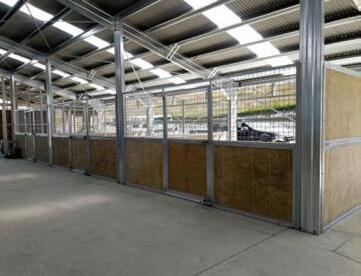



CANTERBURY FARMING July 2023 23 CALVING CALF MEAL CALF MEAL FROM $170 PER TONNE! FROM $170 PER TONNE! CALL STEW 0 27462 2 52 9 CALL STEW 0 27462 2 52 9 - Made fresh on farm. - Custom blended. - Rolled, crushed or bruised grain, peas & maize. - Other Micro-ingredients can be added. - Plus, we can help with sucking problems from blocked auger tubes! WWW.FEEDMIX.CO.NZ


























24 July 2023 CANTERBURY FARMING DAIRY
How self-induced is the dairy squeeze?
Prices of dairy products remain volatile and difficult to predict, interest rates have risen and may yet go higher, compliance costs keep climbing, and staffing issues remain challenging.

At first glance the New Zealand dairy scene doesn’t look bright however it is little different to the situation in the late 1970’s when I first got involved and all I and other young entrants could see was opportunities.


















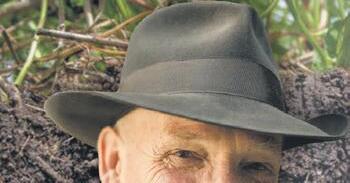
Britain was no longer the guaranteed purchaser of our product, interest rates were climbing annually, subsidies had been removed from fertiliser and committed staff were difficult to find.
Farmers that had been settled by the government after the second world war were looking to sell their properties and the advice we were given was that there was no way to progress from farm labouring to farm
ownership without substantial financial support from family.





The dairy industry is currently this country’s biggest export earner and will continue to be a major player well into the future and solutions to the problems currently faced will be met and overcome, but there are new challenges that have not been faced previously.
Dairy farming in the 70’s and 80’s was recognised as an essential industry and communities and businesses were keen to support. Marginal land was developed, extra fertiliser applied, cow numbers increased, and production steadily rose with the family farm of 120 cows morphing into operations of 300 cows plus.
The notion that people in the wider community with little if any direct link to the land might somehow view
farming practises as environmentally harmful, and support a movement to limit intensity and productiveness was inconceivable.
Time will tell, however there is a sound argument that the dairy industry has laid the base of its own contraction through the overuse of nitrogen fertiliser in the quest for short term sustainability.
The productive capacity of pastoral land is determined by the amount of carbon in the form of soil organic matter in the top 20cm of the soil.






As it is under grazed permanent pasture that carbon can be most quickly sequestered it seems incongruous that intensive pastoral farming is now viewed by many as a problem.
Comparison: Neighbouring highlyproductive dairy properties, brown soil high synthetic N use, black soil less than 30kgN/ha/year.
This paradox may be explained by appreciating that applied synthetic nitrogen burns and destroys soil carbon with irrefutable evidence available from its similar misuse over many years in Europe.














With less carbon in the soil the holding capacity for both nutrient and moisture declines. The initial response to declining growth has often been to apply more nitrogen further accelerating carbon loss.

Cows are grazing ruminants and quality pasture remains the lowest cost feed. To maintain total production, grain and imported palm kernel extract have been used with the latest data from DairyNZ showing the gap between income and the cost of production closing rapidly.
However, not for all. There are those planning to milk fewer cows sometimes on less hectares reducing infra structure pressures with income comfortably exceeding costs. The industry response to steadily decreasing farm profitability, a trend since 1950, has been to lift the number of cows milked by an ever-decreasing number of people.
Those that have opted not to follow that path have employed alternative technology that does not rely on synthetic nitrogen use and aided by science have turned pasture and animal management into an art form, focussing on the enjoyment that comes from a harmonious low stress lifestyle of their own making.

Functional Fertiliser has over the last twenty-five years provided products and supported famers that now steadily grow more pasture with a more even spread throughout the year and enjoy outstanding animal health and performance with lower overall costs.
For more information call Peter on 0800 843 809.

CANTERBURY FARMING July 2023 25
DAIRY Golden Bay Dolomite NZ’s most loved magnesium. call 0800 436 566 or visit www.dolomite.co.nz Electrical problems or maintenance? Use our unrivalled industrial electrical service for: • Dairy sheds and irrigation • Power reticulation • Effluent control • Dryers, conveyors and generators • Switchboards and central supplies North Canterbury 03 313 6104 Leeston 03 324 3752 Nairn Electrical, proudly supporting rural Canterbury since 1975. www.nairnelectrical.co.nz 7 day breakdown service FIXED PRICE CROP MANAGEMENT Fixed price. Fixed price. Guaranteed yield. Guaranteed yield. catalystag.co.nz | 0800 67 770
] with Peter Burton
DairyNZ appoints new chief executive
GEA Farm Technologies NZ chief executive Campbell Parker has been named as the new chief executive at DairyNZ and will be picking up the reins in October.

] by Kent Caddick


The Waikato-based executive brings a wealth of experience to the role and said he is excited to be stepping into DairyNZ at such a pivotal time for the dairy sector.
“I am genuinely humbled and excited to be joining DairyNZ as the next chief executive. I am passionate about the role the dairy sector plays in creating jobs, building communities, and contributing to the success of the New Zealand economy,” Parker said.
“It is important to build on the good work Tim [Mackie] and the team have done over the past decade, and to keep that moving by working collaboratively to ensure long-term sustainability and profitability of the sector.”
Campbell joins DairyNZ from GEA Farm Technologies NZ, where he has been CEO since 2020. He has held previous roles with PGG Wrightson, Bank of New Zealand (BNZ) and Ballance Agri-Nutrients. He holds a Bachelor of Agriculture, majoring in Rural Valuation from Massey University, and grew up on a sheep, beef and dairy grazing farm.
DairyNZ chair Jim van der Poel said he is pleased with the expertise Campbell brings to the chief executive role, including extensive experience in the rural and corporate sectors.
“Recruiting a new chief executive who is passionate about dairy farming and its future has been hugely important to us, alongside leadership skills to continue DairyNZ’s positive direction, as an organisation here first and foremost to represent our dairy farmers,” van der Poel said.
“Campbell brings significant leadership and sector experience that will be invaluable to both DairyNZ’s senior team and in supporting and representing our farmer levy payers, in a wide range of forums.

“Campbell is passionate about agriculture and, in particular, supporting New Zealand dairy to continue as a world-leading sector. We are pleased to welcome Campbell to the team.”

He also thanked departing chief executive, Dr Tim Mackle, for his significant service to DairyNZ and its farmers.
“Tim has been a true advocate for our dairy farmers and a steadying force at DairyNZ, during a period of significant change and challenge for the dairy sector.
“His knowledge, expertise and tireless passion for dairy will be missed. We thank Tim for his commitment to farmers and wish him all the very best.”
Acting chief executive, Peter Scott, will be in place until Parker joins DairyNZ in October.

26 July 2023 CANTERBURY FARMING DAIRY Farm Maintenance Done Right We’ve been getting things Done Right for decades by always stepping up to the plate and getting it right the first time, every time. Get in touch today and get the job Done Right. DAIRY LANEWAYS DRAIN CLEANING RUT BUSTING TRACKS & YARDS DRAINAGE & MORE tarbotton.co.nz 03 307 7065
New job: Campbell Parker has been named as the new chief executive at DairyNZ.
with Julian Weir ]
Aqualinc

Groundwater wells The unsung heroes of irrigation in Canterbury
Groundwater wells are often the most reliable and cost-effective way to obtain water for irrigation, stockwater, dairy sheds and house supplies in rural Canterbury.


The aquifer, well and pump form a crucial component of your irrigation system, providing a reliable source of water day in, day out... until they don’t.
The overall success of your water supply relies on the pump, the well and the aquifer into which the well is screened.

The performance of your supply may change over time – sometimes the well gets better, but more commonly it can degrade. Where would you be if your well ceased performing as needed?
Periodic testing (with specialist interpretation) can provide forewarning of an avoidable catastrophe. It can help you identify issues early on (such as reductions in well performance or equipment ageing) which can save you time and money in the long run by providing valuable data that informs irrigation decisions and improves overall efficiencies.
You can then ensure that you are maximising the value of your water resource while minimising energy use and environmental impacts.
The key purpose of testing is to gather data on the performance of a well (and the groundwater system into which the well is screened).
This information can help you determine the maximum rate at which your well can be pumped long-term, assess the effects on neighbouring wells and/or streams, help you improve the efficiency of your irrigation practices, and plan pump and well maintenance out of season (when the well isn’t in use).
Different tests are available to provide answers to different questions:
• Step tests are designed to measure the performance of your pump and well. Periodic testing lets you monitor the rate of change so you can plan remedial works (such as well redevelopment or

pump reconditioning) before it is too late. Step tests are small-scale tests and can be completed at any time.

• Constant discharge tests involve pumping your well at a constant rate for an extended duration (such as three to seven days) and monitoring the response in neighbouring wells. It is important to isolate the response in a neighbouring well to pumping your well from the effects of pumping other nearby wells. Therefore, it is usually best that constant discharge tests are undertaken outside of the irrigation season (when most other abstractions have ceased). These tests provide information about the aquifer system into which your well is screened.
• Water chemistry and quality sampling enables us to ascertain the likely source of your water, such as young water from a nearby stream or older groundwater from deep groundwater storage. This can then help you manage health and environmental risks.
There are additional specialist tests that can be completed to resolve other specific hydrogeological questions. Also, if your groundwater take consent is up for renewal, it is likely that Environment Canterbury will require you to test your well to demonstrate sustainable yields and effects on surface water and nearby wells.




No two wells are identical, nor are the water requirements and irrigation systems be-



Testing: The key purpose of testing is to gather data on the performance of a well, and the groundwater system into which the well is screened.

tween any two farms. It is important that the right tests are applied to match your needs.
Proper testing requires a specialist combination of fieldwork that is carefully planned, carried out, analysed and interpreted. Specialist field hydrogeologists and irrigation engineers can complete well testing for you and walk with you through whatever process or decision you are facing to ensure your well remains the hero of your irrigation system.

CANTERBURY FARMING July 2023 27
]
T H E S Y S T E M I N C L U D E S : T h e l a r g e s t s o i l s a m p l e r e f e r e n c e a r e a o n t h e m a r k e t t o d a y ( 6 l t r s o r 3 7 0 c u b i c i n c h e s ) . H i g h l y s e n s i t i v e T D T t e c h n o l o g y t h a t i s h i g h l y a c c u r a t e i n a l l s o i l c o n d i t i o n s M u l t i p l e i n s t a l l a t i o n m e t h o d s t o c a p t u r e t h e r i g h t d a t a U n i q u e l y a d a p t a b l e t o d i f f e r e n t c r o p p i n g , o r c h a r d , v i n e , a n d i r r i g a t i o n s y s t e m s t y p e s T h e l o n g e s t s e r v i n g i n s i t u s e n s o r i n N e w Z e a l a n d ( O u r o l d e s t A q u a f l e x i s 2 0 y r s o l d a n d g o i n g s t r o n g ) www.onfarmdata.com Andrew: 022 183 2018 Lyall: 021 223 8666 andrew@onfarmdata com lyall@onfarmdata com FOR ALL YOUR WATER WELL DRILLING & WELL SERVICING REQUIREMENTS Submersible Pump Installation & Removal Potable Water Testing Pump Testing FOR PROFESSIONAL SERVICE FROM AN EXPERIENCED TEAM Rural Water Supply Lifestyle Block Supply Ph - 027 222 1587 / Email - Malcolm@hydrill.co.nz WATER & IRRIGATION
Freshwater Farm Plan practical and pragmatic
taken
 ] by Andrew Curtis
Primary Insight
] by Andrew Curtis
Primary Insight
I’ve been intimately involved in the regulation’s development for the last 18 months, and I’m proud of what’s been produced. They are practical, pragmatic, and importantly have been designed to be property specific.

Recent articles in the farming press have expressed concerns that Freshwater Farm Plans risk being a bureaucratic, top-down, one-size fits all approach that is an invasion of farmer privacy.


So, how do the regulations stack up against such concerns?
The regulations require every farm operator with a property over 20ha for pastoral and arable land uses and 5ha for horticultural land use, to prepare a farm plan.
The plans must then be certified within 18 months (are the risks and actions contained in the plan fit for purpose) and audited within a year (are the actions being undertaken). Subsequent audit timeframes relate to whether the actions have been implemented, and plans must be re-certified every 5-years to provide a periodic check that they remain fit for purpose.
Plans will be rolled out over time likely on a sub-region basis. This will help to manage the inevitable ‘hump’ that always occurs for regulations of this type.
Freshwater Farm Plans are risk based.
They require a farm’s risks to freshwater be identified and actions put in place to address these. This approach means each farms actions are specific to that property.

A farm that has very few risks results in a simple plan with limited actions, whereas a plan for an intensively farmed property within a sensitive catchment will have multiple actions to manage risk.



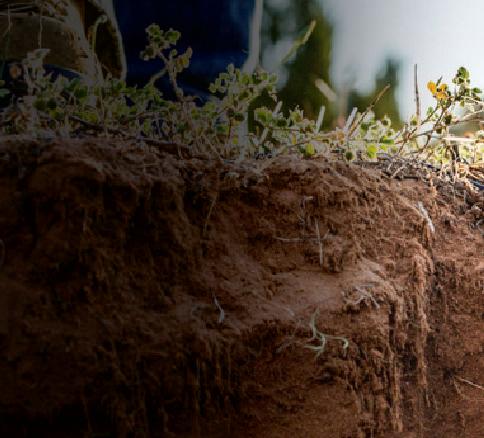
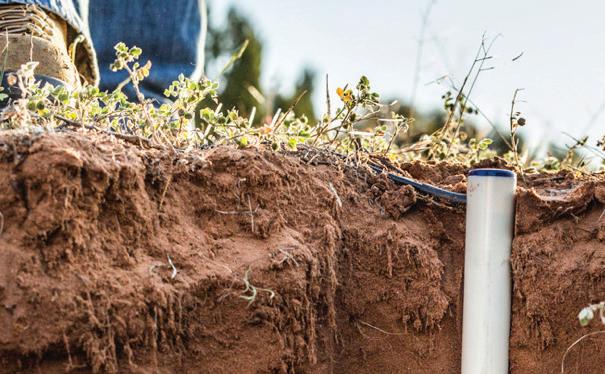
The approach makes sense from both freshwater management and equity between farms perspectives. It ensures the potential risks from small intensively farmed operations are managed, and that properties with limited risks are not burdened with unnecessary requirements.
Another feature of the freshwater farm plan is the adoption of a systems thinking approach to risk identification.




Alongside the farming activities being undertaken, the farm’s landscape risks (inherent vulnerabilities) and local area which the farm impacts (catchment context) also need to be considered. This ensures risks and their related actions are context specific.

The data privacy concern is dealt with through only the identified risks and their associated actions being held by the Council. The farm plan detail remains with the farmer.
Despite the above, there are challenges ahead for the successful implementation of freshwater farm plans including:
• Enabling industry sustainability programmes to be formally recognised as a













come to fruition
delivery pathway through establishing an equivalence assessment process,
• Ensuring farmers have a good understanding of what’s required so they can avoid unnecessary cost from over-zealous farm plan service providers,

• Upskilling rural professionals to support farmers with farm plan development and become certifiers, noting developing a workforce of competent certifiers is key to success.

28 July 2023 CANTERBURY FARMING WATER & IRRIGATION
]
While the Freshwater Farm Plan regulations have
longer to
than some would have liked, when you look at where they’ve landed, I think the wait was worthwhile.
‘
The farm’s landscape risks and catchment also need to be considered.
Is irrigation water supply infrastructure critical?



In mid-June, the Department of the Prime Minister and Cabinet (DPMC) initiated a consultation programme titled ‘Strengthening the Resilience of Aotearoa New Zealand’s Critical Infrastructure System’.
by Stephen McNally
IrrigationNZ Principal
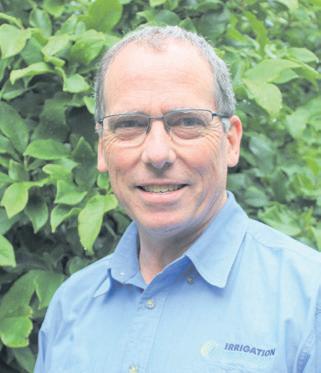







 Technical Advisor
Technical Advisor








The primary objective is to ensure a secure foundation for a productive, sustainable, and inclusive economy in New Zealand.
Over the past year, IrrigationNZ has engaged in discussions with Te Waihanga, the Infrastructure Commission, as well as MPI, MBIE, and MfE, regarding the crucial role of irrigation supply infrastructure in supporting the primary sector. Our focus has been on determining whether irrigation water storage and distribution align with the accepted definitions of critical infrastructure.
As outlined by DPMC documentation, critical infrastructure encompasses services that are indispensable for the functioning of society, the economy, public safety and security, and the provision of public services. During recent discussions with infrastructure risk advisors, it became evident that any loss, damage, or disruption to these entities can significantly impair the provision of essential services, potentially endangering lives, and livelihoods.
Although New Zealand law does not currently define critical infrastructure, numerous entities across the country are considered essential services. These include, but are not limited to, energy, telecommunications, water services (freshwater, wastewater, and stormwater), food and grocery providers, financial services, cloud data storage provid-
ers, and the transport system.



Considering the role of large-scale and community-level irrigation water supply schemes, it is apparent that they play a similarly critical role in substantial portions of the rural economy and social fabric. The failure or inability of these schemes to meet the demands of irrigated operations could have severe repercussions.
The consultation programme identifies four megatrends that will reshape New Zealand’s infrastructure system, with climate change being the first highlighted trend. Climate change is projected to undermine the resilience of New Zealand’s critical infrastructure by intensifying stresses, vulnerabilities, and the risk of shocks. The recent impact of Cyclone Gabrielle serves as a reminder, among others, of the vulnerability of our primary sector.
New Zealand’s first National Adaptation Plan (NAP) released in August 2022 emphasises the direct effects of climate change, which include more frequent and extreme weather events (such as storms, heatwaves, and heavy rainfall) posing risks to infrastructure resilience; fewer frost and snow days impacting hydrology and the seasonal snowmelt cycle, thereby affecting the energy sector; more frequent and severe droughts, exerting pressure on freshwater resources and potentially affecting the reliable supply of drinking water and electricity generation; and sea-level rise, which may compromise existing communities and critical infrastructure assets.
IrrigationNZ has engaged with key stakeholders to raise awareness that water infrastructure encompasses more than just human drinking water, as mentioned in the NAP. Te Waihanga has welcomed our input on several of their work programs in this regard.
The infrastructure chapter of the NAP outlines a series of actions aimed at enhancing the resilience of infrastructure services critical to New Zealand’s economy and communities in the face of climate change. Resilient infrastructure is of utmost importance as it supports community and business adaptation while safeguarding the well-being of future generations.
IrrigationNZ is working closely with government agencies to determine the position of irrigation infrastructure in regulatory priorities and the potential implications of proposed legislation, such as the Natural and Built Environment Bill, and the National Planning Framework.



The new Emergency Management Bill proposes a definition for critical infrastructure, which will expand
upon the entities already designated as “lifeline utilities” under the current Civil Defence Emergency Management Act 2002 (CDEM Act). In this document, “critical infrastructures” refer to the assets, systems, and networks designated as such through the implementation of the Emergency Management Bill.
BY LINDSAY
CANTERBURY FARMING July 2023 29 WATER & IRRIGATION
IRRIGATE WITH CONFIDENCE. IRRIGATION SYSTEMS REMOTE MANAGEMENT PRECISION VRI
]
]
]
Rather difficult season ends


July 1 signified the opening of a new wool selling season after what could be described as a rather difficult 2022-23 season where the majority of strong wool types struggled to gain momentum until the last few weeks when best styles enjoyed a serious boost, mid-micron types fluctuated wildly before faltering significantly, and fine wool types enjoyed superb support during their main sale months before looking shaky towards the end of June.


] with Rob Cochrane ] Wool Procurement Manager, ] PGG Wrightson Wool








Wool quantities coming onto the market remained solid throughout the season with several auction sales accommodating volumes of old season wool which had been held over from previous seasons, either in broker stores or in farm wool sheds.

Due to climatic conditions experienced in South Island areas during 2022 and early 2023, many strong wool types contained medium to high discolouration confirmed by the accompanying colour test results, creating difficulty not only for growers hoping to gain better financial gain than the previous season but also for exporters struggling to compile parcels of similar type wools to suit their manufacturer customers.




Added to the climatic yellowing influence on greasy wool colour, was also an obvious general lack of clip preparation carried out in farm woolsheds, due to farmer apathy as a direct result of long term poor wool prices and the perceived cost savings of reducing labour units at shearing time, hence many lines of otherwise visually even (for staple length and colour) body wools, were discounted due
to their containment of short, discoloured oddments.


Mid-micron wool types throughout the season also evidenced poorer than usual colour, attributable to a humid and damp growing

season and an abundance of grass in most areas supporting such wool breeds which, in general, prefer a drier and cooler environment.
While most wool clips had been prepared well, some of the coarser types may have been better supported had they been prepared in a more ‘traditional’ way although, due to stocks of similar wool types held in other countries producing mid-micron wools, market prices did not encourage growers to take more care.
With a significant number of merino farmers subscribing to the fixed price forward contracts, offered by several major wool brokers for part of the growers’ annual wool clips, allowing price certainty and a degree of insulation from spot market volatility, the remainder of merino types however drew extremely solid support in the Christchurch auction room throughout the August to October main sales months.
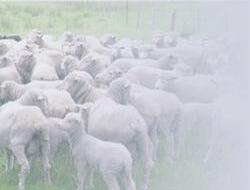
A negative feature during the 2022-23 season was that several lines of merino fleece wools were accompanied by tensile strength test results poorer than expected (reported


as NKT or Newtons per Kilotex) possibly affecting yarn spinner confidence.



While many New Zealand grown merino wools are regarded as superior compared to some of other origins, Australian market levels significantly influence market prices here, due to sheer quantities produced there, and with Australian wool auction markets reporting much weaker demand recently, possible further head winds could be expected into the new season.
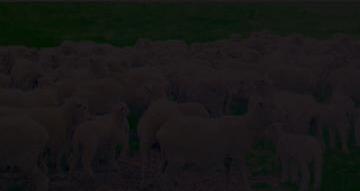
Mid-micron wools suffered a substantial fall in favour, both in New Zealand and Australia, by season’s close, suggesting a murky outlook.
Best styled pre-lamb shorn strong wool full length fleece types, along with best styled second shear strong wool types, enjoyed substantial demand improvement throughout the final few weeks of the season, with large price differentials obvious between best styles and poorer styles, another positive reason for care to be taken in the woolshed to ensure delivery of a product gaining maximum competition.
That’s my view.


30 July 2023 CANTERBURY FARMING LIVESTOCK
Boarding Enrolments Open nelsoncollege.school.nz • Welcoming family environment • High-level academic & leadership programmes • More than 30 different sports options • Year-round activities across the Nelson/Tasman region • Competitive rates & no school fees START YOUR LEGACY
Canterbury rocks for deer in changing national scene

Canterbury still rocks for deer, with nearly a quarter of a million of the animals being farmed in the region in 2022 and nearly three-quarters of the national herd farmed on the South Island, according to newly released figures.
] with Ali Spencer
The 2022 figures were reported in the fiveyearly Agricultural Production Census (APC), last conducted in 2017, and account for the 30 June production year.
With a total of 334,000 hinds, the 2022 breeding hind herd was smaller than in 2017, while numbers of stags increased, especially in Canterbury and Otago, as more were retained for antler production.

he farm census figures show environmental constraints, land-use change and some big changes to breeding hind policies are affecting where and how deer are farmed across New Zealand, the industry board Deer Industry NZ (DINZ) has commented.

Rising costs of production are hitting every part of the agricultural sector hard and afforestation is affecting livestock numbers, it noted.
Expected downward pressure on milk, lamb and beef will strain farmers’ incomes in the coming year, however “market comments continue to point to stable to improving conditions for venison and velvet.”
It will be vital to continue the strategic efforts to create diversified demand in three
key regions around the world: the US, Europe and China and wider Asia.
New DINZ board member Paddy Boyd is looking forward to bringing another strong farmer’s voice to the eight-strong DINZ board, chaired by Criffel Station’s Mandy Bell, as one of its four producer-appointed representatives.

The well-known and respected deer farmer and manager of Haldon Station in the McKenzie Country is “very excited” about the opportunity. His three-year term starts on 1 July, when he replaces retiring South Canterbury/ North Otago deer farmer Kris Orange.

Boyd will join recently re-elected velvet processor representative PGG Wrightson’s national deer and velvet manager Tony Cochrane, along with venison processor representative Alliance Group’s general manager strategy Nigel Jones.
Under the board’s direction, with increasing red tape from government adding more cost and worry for deer farmers, the DINZ executive will be advocating hard for deer farmers in many areas.
Latest on its plate are the new freshwater farm plan regulations that come into force on 1 July 2023, and first to be felt by pro-
ducers in Southland and Waikato. The timing requirements for audits and the prospect of farmers being fined for failing to implement changes are two priority items of concern for deer farmers.
Another big item is the ongoing saga with government around New Zealand’s greenhouse gas (GHG) reduction. DINZ recently repeated its committed to working with the pastoral sector and government to find the best and fairest means of achieving emissions reduction.
This was one of the items discussed be-


tween the 11 pastoral sector leaders and Prime Minister Chris Hipkins and senior government ministers when they met in midJune. The leaders agreed to work together to find ways to measure emissions on-farm and to incentivise the uptake of emissions reduction activities.
Currently, it is written into legislation that agricultural emissions will be priced from 1 January 2025.
DINZ’ position was, “as it always has been”, that agriculture must be kept out of the Emissions Trading Scheme and that New Zealand agribusinesses should monitor and take steps to reduce GHG emissions, DINZ chief executive Innes Moffat has noted.
Deer farmers are already committed to managing and improving their resource use through having farm environment plans and most know their GHG numbers. They are also investing in science to find real tools to reduce methane in extensive pastoral systems.
Emissions “need to be managed and steps taken to reduce their impact on the climate,” the organisation agrees, but, not “at the expense of the viability of farming families across New Zealand.”
Smartrace proves to be a great option
Giving ewes a slow-release dose of important trace elements makes sense to Jeremy Pitts.
So, he switched to dosing ewes with a Smartrace capsule of selenium, cobalt and iodine.
“I’ll definitely do it again this season.”
“We’ve had the best ewe survival rate over winter and lambing for several years.”
The extensive nature of Jeremy and Hayley Pitt’s 5500-hectare high country property, Mt Gladstone Station, means limited trips through the yards for ewes.
“I really like that we can give the ewes what they need with two capsule doses – prior to tupping and then at shearing in late pregnancy,” said Jeremy.
The property runs mediummicron Merino ewes, hoggets and wethers. Smartrace really fits the animal health plan for the ewes, and has potential for wether flocks who require long term supplementation.

The capsule is two pills of trace elements, held together with a biodegradable paper. The paper dissolves and the pills rub together.
As they scratch together the elements are released.
“I like the fact that there is no plastic going into the sheep.”
The Awatere property in Marlborough has a proven issue with low selenium soils. Cattle showed up with selenium
deficiency 15 years ago and resolving it made a huge difference to fertility. Ewes have always had selenium, iodine and cobalt supplementation, but Jeremy was
keen to try a product that gave a longer-acting dose.
“Selenised drenches are more short-term and we don’t drench often enough.”
“I decided against the injection as it’s another needle for ewes, when they are already getting two or three vaccinations.”
Jeremy read about Smartrace in the Vet Marlborough newsletter and grabbed a sample pack of capsules from the vets when in town.
The capsules were given to ewes in
SMARTRACE ADULT SHEEP
Smartrace Adult Sheep is available in the following formulation (based on 48g bolus on sheep weighing over 40kg):
• Selenium (Sodium Selenate)
66mg
• Iodine (Calcium Iodate)
762mg
• Cobalt (Cobalt Carbonate)
146mg
Available from vetpak.co.nz

tucker still had the capsule inside after four months.
“It was still breaking down.”
“It was really interesting to see.” Like many treatments, proving the benefits of a supplement is hard to do, Jeremy said.
“But I feel that they are going better.”
“The lambing percentage in the ewes was the same but the ewe survival rate was much improved.”
“We only lost three ewes from ram joining in June to September.”
“Our wool clip was also up but that could also be the season too.”
Iodine regulates ewe body temperature and helps foetal development.
the race using an adapted capsule gun, and Jeremy estimates only 12 or so capsules were immediately coughed up out of 3200 ewes. Any ewes seen doing this in the race were given another.
Smartrace has released a new applicator that will make the dose process even faster.


Research by Agrimin (the manufacturer) shows the capsules deliver all three ingredients for up to at least four months, but potentially beyond. Jeremy noticed that a ram killed for dog
Jeremy said iodine is really important pre-lamb so this is probably the key time to give a capsule, if farmers just wanted to give one. His ewes typically graze high country oversown-top dressed pastures, which are of moderate quality for much of the year.
Giving long-acting selenium means the Pitts have to make sure they give only unselenised drench to the ewes.
“It takes a bit of planning to make sure staff know not to drench ewes with selenised drench, but we write it all on a whiteboard in the shed.”
Jeremy’s advice to other farmers is to give Smartrace a go, as it’s a great option.
CANTERBURY FARMING July 2023 31 LIVESTOCK
Jeremy Pitts on his high country property. Photo: Hayley Pitts
“We’ve had the best ewe survival rate over winter and lambing for several years.”
Increase: More stags in the 2022 Canterbury deer herd. Photo: Richard Hilson.
NZPork disappointed at inaction on equal welfare standards
] by Kent Caddick

The call comes following what NZPork describes as a ‘disappointing “decision by Parliament’s Primary Production select committee.
The committee has considered a petition signed by almost 3,500 calling for equal animal welfare standards to be applied to imported pork as those for New Zealand-raised pork.

Approximately 60 per cent of pork consumed in New Zealand is imported, with most of it produced in countries using practices that are illegal in this country.
However, in its final report on the petition started by NZPork policy advisor Frances Clement, the select committee has opted not to ask Parliament to investigate avenues to address the inequalities facing producers of New Zealand pork.
“This is a disappointing decision by the Members of Parliament on the select committee,” NZPork chief executive Brent Kleiss said.
“The unfairness of the regulations on New Zealand’s pig farmers clearly resonated with thousands of New Zealanders who supported the petition,” Kleiss said.


“Our animal welfare and environmental standards are more stringent than most countries supplying pork into New Zealand. What we are asking for is a level playing field for New Zealand pig farmers who must compete with cheaper imported pork produced to lesser standards.”
Kleiss said they understand the complexity of the situation and trade obligations cited by the select committee which means domestic products cannot be treated more favourably than similar imported products.

“However, domestically-produced pork is currently being placed in a less favourable


Level the playing field: NZPork wants to ensure imported pork meets the same animal welfare standards as New Zealand born and raised pork.
position than imports. We urge policy-makers and Parliament to work with us to come up with a constructive solution that is consistent with our trading position.”
He said NZPork has consistently supported farmers to implement welfare standards reflecting current science and international good practice.
“Over many years, code of welfare updates have required change and investment by New Zealand pig farmers with no similar standards ever required for imported pork. This is unfair to New Zealand’s pig farmers.
“Currently, pork and cured pork for retail sale must be labelled with the country or countries where the animal was raised.
“However, because the regulations allow a whole list of possible countries to be




referred to on one product, particularly for cured products such as ham and bacon, it is not at all clear whether the pork is New Zealand raised or imported.
“Furthermore, a wide range of processed pork products such as marinated pork and pork sausages that may use imported pork are not even covered by the current regulations.
“Clearer regulations requiring labelling of New Zealand pork and imported pork with specific country of origin information would at least go some way to providing consumers with information to choose New Zealand pork based on its high welfare and environmental standards.”
Kleiss said welfare standards for pork production in New Zealand are among the most rigorous of any country.
“Gestation stalls are banned in New Zealand. However, most of the countries exporting pork to New Zealand allow sows to be contained in gestation stalls for the first four weeks of their pregnancy. In the USA, this is allowed for a sow’s entire pregnancy.
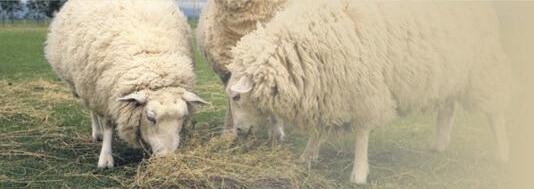
“Piglets are not castrated in New Zealand but are routinely castrated in Europe, the USA and Canada. Spain, Poland and the USA do not require pain relief to be used during this procedure.
“Australia permits piglet castration with pain relief if the animals are less than three weeks old,” Kleiss said.
32 July 2023 CANTERBURY FARMING
NZPork wants the Government to take urgent action to ensure imported pork meets the same animal welfare standards as New Zealand born and raised pork.
Fonterra launches new nutrition science venture arm
Fonterra has announced a new corporate ventures arm to incubate, scale and invest in ventures in the area of nutrition science.
] by Kent Caddick
The business, provisionally named Nutrition Science Solutions (NSS), will operate as a standalone business within Fonterra with its own board and CEO.
Chief executive Miles Hurrell said Fonterra is committed to staying at the forefront of nutrition innovation and creating new value streams for the Co-op.

“When we released our long-term strategy in September 2021, we identified nutrition science solutions as an area with future growth potential,” Hurrell said.
“Nutrition science is a segment of the global health and wellness category that goes beyond everyday lifestyle and wellness products. Given our expertise in dairy science, we committed to exploring the potential for Fonterra to play more boldly in this space.
“We have developed a business case and





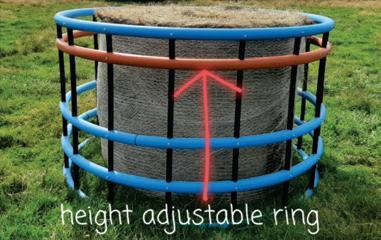



SCORCH
agreed on a way forward, which includes establishing a corporate ventures arm with access to our dairy science and innovation expertise, combined with the agility of a startup.


“The business will incubate and scale a portfolio of disruptive ventures by developing solutions that combine science, nutrition and technology to make a real impact on human health.”
Hurrell said NSS will seek out, partner with and invest in global start-ups who will benefit from access to Fonterra’s dairy science expertise and understanding of the global market, while Fonterra will benefit from access to emerging technologies, advancements in science, and novel channels to market.
“This is a new way of working for Fonterra, but one in which we see a lot of potential.”






As part of the announcement, Fonterra has disclosed its first investment through the new ventures arm, a US$10 million for
a minority shareholding in Pendulum, a biotech company pioneering the next frontier of metabolic health through its microbiome-targeted products.
The growth-stage San Francisco-based company specialises in targeting metabolic health through evidence-based microbiome solutions.
The partnership will see Pendulum and Fonterra establish a presence in global markets, co-develop and commercialise next
generation microbiome products that are scientifically formulated to make measurable improvements to people’s health.
“This strategic partnership will enable Fonterra and Pendulum to leverage each other’s strengths – Fonterra’s innovation, manufacturing expertise and established leadership in global markets, together with Pendulum’s deep innovation, microbiome expertise and growing leadership in the US market,” Hurrell said.
CANTERBURY FARMING July 2023 33 0800 726 724 www.scorch.co.nz Terrestrial Wireless ADSL Fibre VoIP RBI GET CONNECTED WITH Scorch
COMMUNICATIONS
Broadband
Nutrition: Fonterra chief executive Miles Hurrell says the Co-op’s new corporate ventures arm will invest in ventures in the area of nutrition science.
Ranger Raptor BiTurbo diesel for NZ
The Next-Generation Ford Ranger Raptor will soon be available in New Zealand with the 2.0-litre BiTurbo diesel engine.
]Article supplied by FordNZ






Ford New Zealand says the Ranger Raptor 2.0L BiTurbo diesel is now available to order from any Ford Dealership, with first arrivals from October 2023 onwards.
Built on the success of the previous-generation Ranger Raptor BiTurbo with a power output of up to 150kW and 500Nm of torque from 1,750 rpm, the Next-Generation Ranger Raptor BiTurbo Diesel offers an additional engine of choice.
The Ranger Raptor BiTurbo follows the high energy design of the V6 EcoBoost Raptor.
Emphasising the width of the pick-up are flared wheel arches accommodated by muscular 17” wheel design wrapped in BFGoodrich All-Terrain KO2 tyres, Ford truck DNA C-clamp Matrix LED headlamps and the iconic bold F-O-R-D lettering on the grille.
Ford Marketing Manager, David Herbert said designed and engineered as the ultimate Ranger model with Ford’s Performance DNA at its core, the Ranger Raptor has exceeded expectations, setting new benchmarks as the only factory-built performance truck for high-speed off-roading offered in New Zealand.
“The Next-Generation Ranger Raptor has been much sought after since its launch last year,” Herbert said.

“Many of our customers have also been asking for the return of the BiTurbo and we are responding by adding the formidable,
tried and tested BiTurbo Diesel engine variant to offer another option for Raptor customers and off-roading enthusiasts.
“Also with the Clean Car Scheme at the top of many minds, Ford’s BiTurbo Diesel is an excellent option to avoid the higher fees. It remains one of the cleanest yet most capable powertrains available in New Zealand.”
In addition to the Raptor BiTurbo joining

Addition: Ford says the Ranger Raptor 2.0L BiTurbo Euro 6 Diesel offers a second powertrain option to meet the different needs and preferences of New Zealand customers.
the showroom floor, there are other changes afoot with the Ford Ranger line up with model year 2024, arriving from October 2023.
Ford New Zealand is also introducing the Ranger Sport exclusively with the BiTurbo diesel powertrain in both RWD and 4WD.
Meanwhile the Ranger XL models will now come standard with towbar and Integrated Brake Controller.
34 July 2023 CANTERBURY FARMING




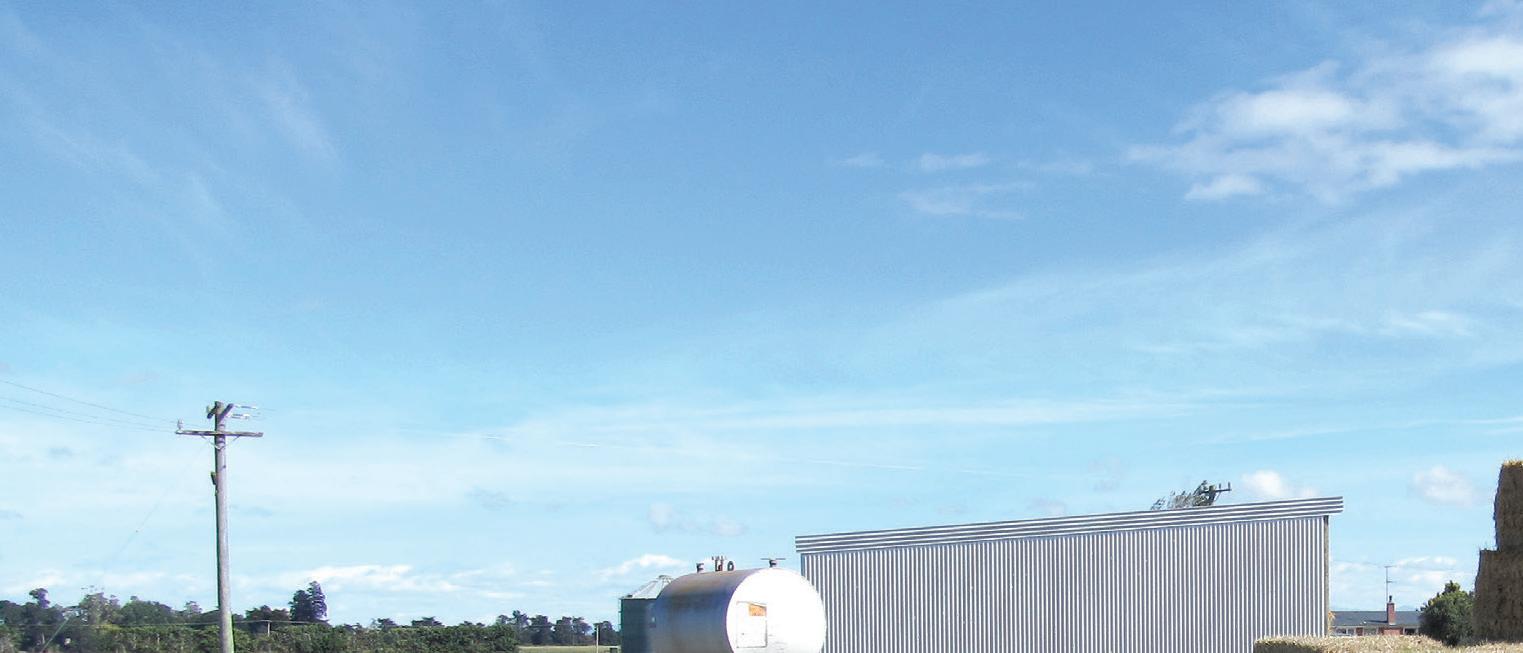










CANTERBURY FARMING July 2023 35 Helpingtofightcrimeinthecommunityforover25years LEADERS IN CUSTOM DESIGNED SECURITY CAMERA SYSTEMS • Remote access from smartphone or laptop • Entry detection and line crossing alerts • License plate recognition cameras • Steerable camera function • High quality night time images • Solar and wifi solutions Protect your business, farm or home the smart way CHECK YOUR PROPERTY ANYWHERE, ANYTIME WITH OUR LIVE VIEW CAMERA APP MANAGE YOUR SAFETY & SECURITY ANYWHERE, ANYTIME! Hartley Curd | 021 328 301 Call 0800 788 39357 | www.masterguard.co.nz LOCALLY OWNED & OPERATED
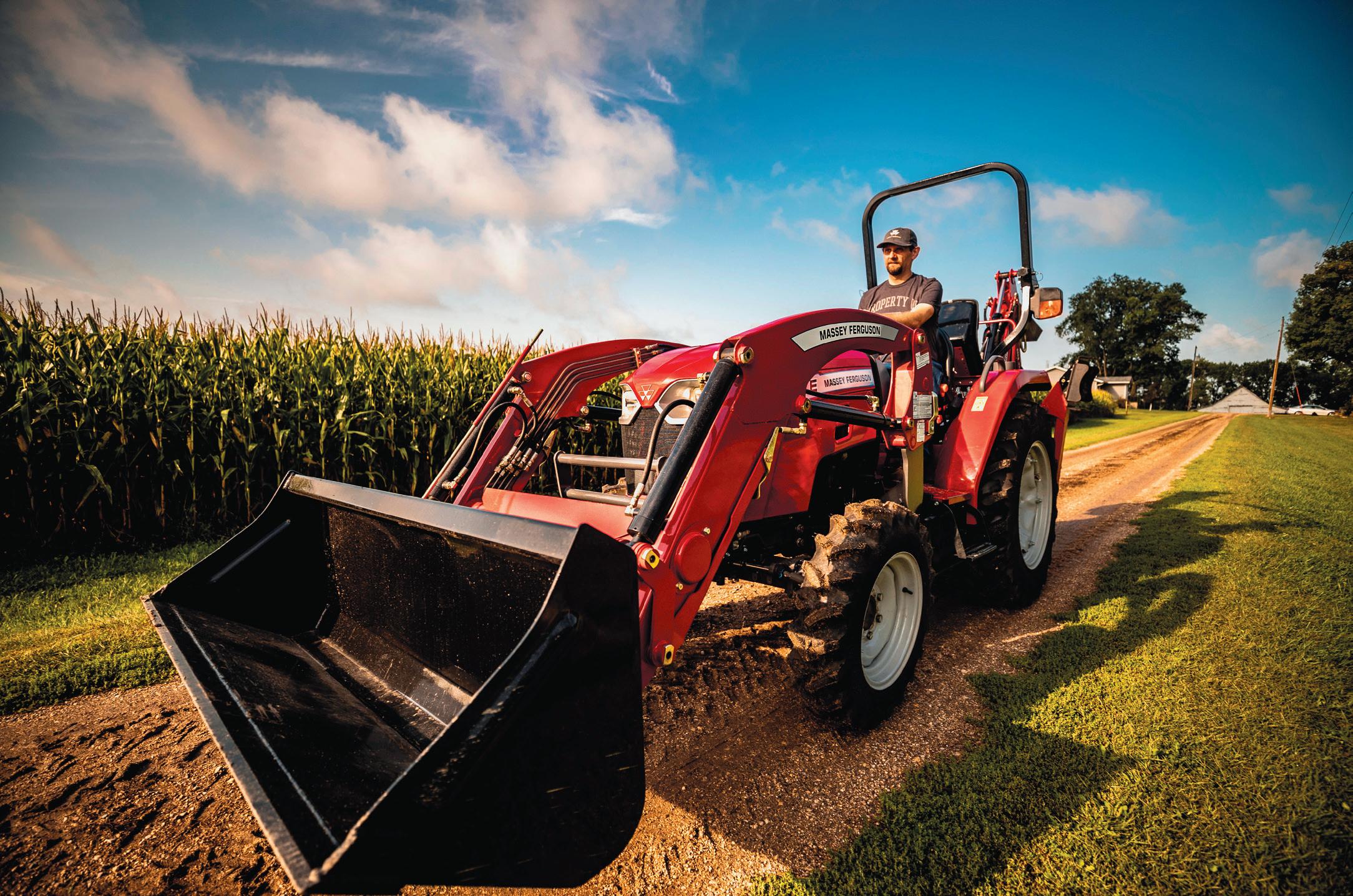



DEPENDABLE. VERSATILE. PRACTICAL. JUST LIKE YOU. ^Finance under chattel mortgage with an interest rate of 1.99% pa, 30% cash deposit, the GST component repaid in the 4th month, and monthly repayments in arrears over a 36 month term. Available for new retail orders placed before COB 31 July 2023, and installed within two calendar months of arrival, to approved purchasers for business purposes only. Fees, terms & conditions apply. Finance provided by AGCO Finance Ltd GST No. 88-831-861. Offer available at participating Massey Ferguson Dealers only, while stocks last. * MF 1800 E Compact Tractor MF1800 MF2800 E SERIES 1.99% FINANCE THE ECONOMICAL OVER ACHIVERS. MF 2800 E Compact Tractor & * THE LATEST IN THE MASSEY FERGUSON COMPACTS
















































































































































































































































































































































































































































































 Technical Advisor
Technical Advisor































































































